Intel Core i7-12700K vs AMD Ryzen 9 5900X and 5800X Face Off: Intel Rising
The Intel Core i7-12700K vs AMD Ryzen 9 5900X and Ryzen 7 5800X battle is yet another example of Intel's new bare-knuckle approach to pricing with its Alder Lake processors. Intel's pricing places the 12700K against mid-range Ryzen 5000 models, but today we're putting the $408 Core i7-12700K up against the decidedly more expensive $549 Ryzen 9 5900X as well as the ~$390 Ryzen 7 5800X. That's because Intel's Alder Lake chips are surprisingly powerful, already earning key upsets against higher-priced Ryzen chips on our list of Best CPUs for gaming and CPU Benchmark hierarchy.
As seen in our previous Intel Core i9-12900K vs Ryzen 9 5900X and 5950X and Intel Core i5-12600K vs AMD Ryzen 5 5600X and 5800X faceoffs, Intel's hybrid x86 Alder Lake design represents the company's most disruptive architectural shift in a decade. As a result, Intel upsets AMD's highest-end mainstream chips, particularly in price-to-performance metrics.
However, Alder Lake does have an Achilles heel: Intel launched the chips without the B- and H-series motherboards that tend to be the affordable favorites for mainstream gamers. That means you'll have to buy a pricey Z690 motherboard, but at least you get cutting-edge connectivity as part of your purchase — Intel baked in leading-edge exclusive options like the DDR5 memory and PCIe 5.0 interfaces that outstrip AMD's venerable AM4 platform. You can also opt for DDR4 models, which is good given that DDR5 is hardly available and selling for scalper pricing.
While Intel's new hybrid design is a game-changer, it also has a few early performance teething pains in Windows 10. This means the AMD vs Intel rivalry is anything but the clear-cut victory it appears to be on the benchmark charts. Below we've put the Core i7-12700K vs Ryzen 9 5900X and Ryzen 7 5800X through a six-round faceoff to see which chip takes the crown in our gaming and application benchmarks, along with other key criteria like power consumption and pricing. Let's see how the chips stack up.
Features and Specifications: Intel Core i7-12700K vs Ryzen 9 5900X and Ryzen 7 5800X
| Header Cell - Column 0 | U.S. Price | Cores | Threads | P-Core Base/Boost | E-Core Base/Boost | TDP / PBP / MTP | DDR4-3200 | L3 Cache |
|---|---|---|---|---|---|---|---|
| Ryzen 9 5900X | $549 | 12P | 24 threads | 3.7 / 4.8 GHz | - | 105W | DDR4-3200 | 32MB (1x32) |
| Core i7-12700K / KF | $409 (K) - $384 (KF) | 8P + 4E | 12 Cores / 20 threads | 3.6 / 5.0 GHz | 2.7 / 3.8 GHz | 125W / 190W | DDR4-3200 / DDR5-4800 | 25MB |
| Ryzen 7 5800X | $449 (typ. $390) | 8P | 16 threads | 3.8 / 4.7 GHz | - | 105W | DDR4-3200 | 32MB |
Alder Lake combines big and fast Performance cores (P-cores) for latency-sensitive work with small and powerful Efficiency cores (E-cores) for background and multi-threaded workloads. As a result, Intel's hybrid architecture brings what we would normally consider 'odd' thread arrangements. That's because the P-cores are hyper-threaded, while the E-cores only have a single thread.
The Core i7-12700K lands with the same $409 pricing as the previous-gen Core i7-11700K, but it comes with 33% more threads. The Core i7-12700K has eight P-cores and four E-cores, for a total of 20 threads. The P-cores run at a 3.6 / 5.0 GHz base/boost, while the E-cores weigh in at 2.7 / 3.8 GHz. The chip is fed by 25MB of L3 cache and 12MB of L2.
The 12700K comes with the integrated UHD Graphics 770 engine with 32 EUs that run at a 300 MHz base and boost to 1,500 MHz, an advantage over the graphics-less Ryzen 9 5900X and 5800X. That means Intel wins by default if you don't have a discrete graphics card. For a more direct comparison, you can look at Intel's own Core i7-12700KF, an identical chip that lacks the in-built GPU, for $384. That $25 price reduction is tempting if you plan to use this chip for a gaming rig that doesn't need integrated graphics — you'll end up paying $65 less than the graphics-less Ryzen 7 5800X. None of these chips in the faceoff come with a bundled cooler, and the 12700K comes with 125W PBP (base) and 190W MTP (peak) power ratings.
The 12700K goes toe-to-toe with the 6-core, 12-thread Ryzen 5 5600X that has long been the favorite for enthusiasts because of its incredible blend of pricing and performance. These chips come with 65W and 105W TDP ratings, respectively, 32MB of L3 cache, and have only high-performance cores. Both chips support DDR4-3200 memory and the PCIe 4.0 interface.
All Alder Lake chips support DDR4-3200 or up to DDR5-4800 memory (odd DDR5 population rules apply). Alder Lake chips also expose up to 16 lanes of PCIe 5.0 and an additional four lanes of PCIe 4.0 from the chip for M.2 storage. Intel also added 12 lanes of PCIe 4.0 to its chipset (in addition to its 16 lanes of PCIe 3.0), and now offers a total of 28 lanes. Intel has also widened the DMI connection between the chip and the chipset, which now serves up twice the throughput. The increased DMI throughput is also beneficial for Z690's bolstered connectivity options, like the new second USB 3.2 Gen 2x2 20 Gbps connection (other new features are listed here).
These new technologies add cost to the Z690 motherboards that house the chips, and DDR5 memory is largely unavailable. However, there are DDR4-powered Z690 options available. Intel hasn't launched the value-centric B- and H-series chipsets yet, so platform pricing will be high for now. It is noteworthy that there is quite a pricing spread between the flagship and bottom-of-the-barrel Z690 options, but, as expected, prices are generally high this close to the launch.
Winner: Intel
Intel's chip pricing is an advantage. The Z690 platform also has a clear connectivity advantage: With DDR5 and PCIe 5.0 on the menu, AMD's AM4 platform finds itself looking a bit long in the tooth, but Intel's new features do make for more expensive motherboards. The lack of B- and H-series boards at launch doesn't help matters, either. Additionally, DDR5 pricing is currently brutal, and we can expect that to continue for some time. Fortunately, the 12700K is just as fast with DDR4 in the majority of tasks.
Given its new hybrid architecture with two types of cores, Intel's core counts aren't directly comparable to AMD's due to their different capabilities. Our performance results will dictate the value of the overall designs.
The Core i7-12700K comes with integrated graphics by default, though you can sacrifice those for a lower price point. Meanwhile, you'll have to look to AMD's Ryzen 7 5700G APU if you want integrated graphics, but that chip isn't really directly comparable to the 12700K. That means Intel wins by default if you need an iGPU.
Gaming Benchmarks and Performance: Intel Core i7-12700K vs Ryzen 9 5900X and Ryzen 7 5800X
This article is an overview of our much more in-depth testing in our Intel Core i7-12700K review. We're focusing on our Windows 11 test results in this article, but be aware that you could encounter odd performance in some cases with Windows 10. We have the full details in our review.
Below you can see the geometric mean of our gaming tests with the Core i7-12700K vs the Ryzen 9 5900X and Ryzen 7 5800X at 1080p and 1440p, with each resolution split into its own chart. As per usual, we're testing with an Nvidia GeForce RTX 3090 to reduce GPU-imposed bottlenecks as much as possible, and differences between test subjects will shrink with lesser cards or higher resolutions.
Get Tom's Hardware's best news and in-depth reviews, straight to your inbox.
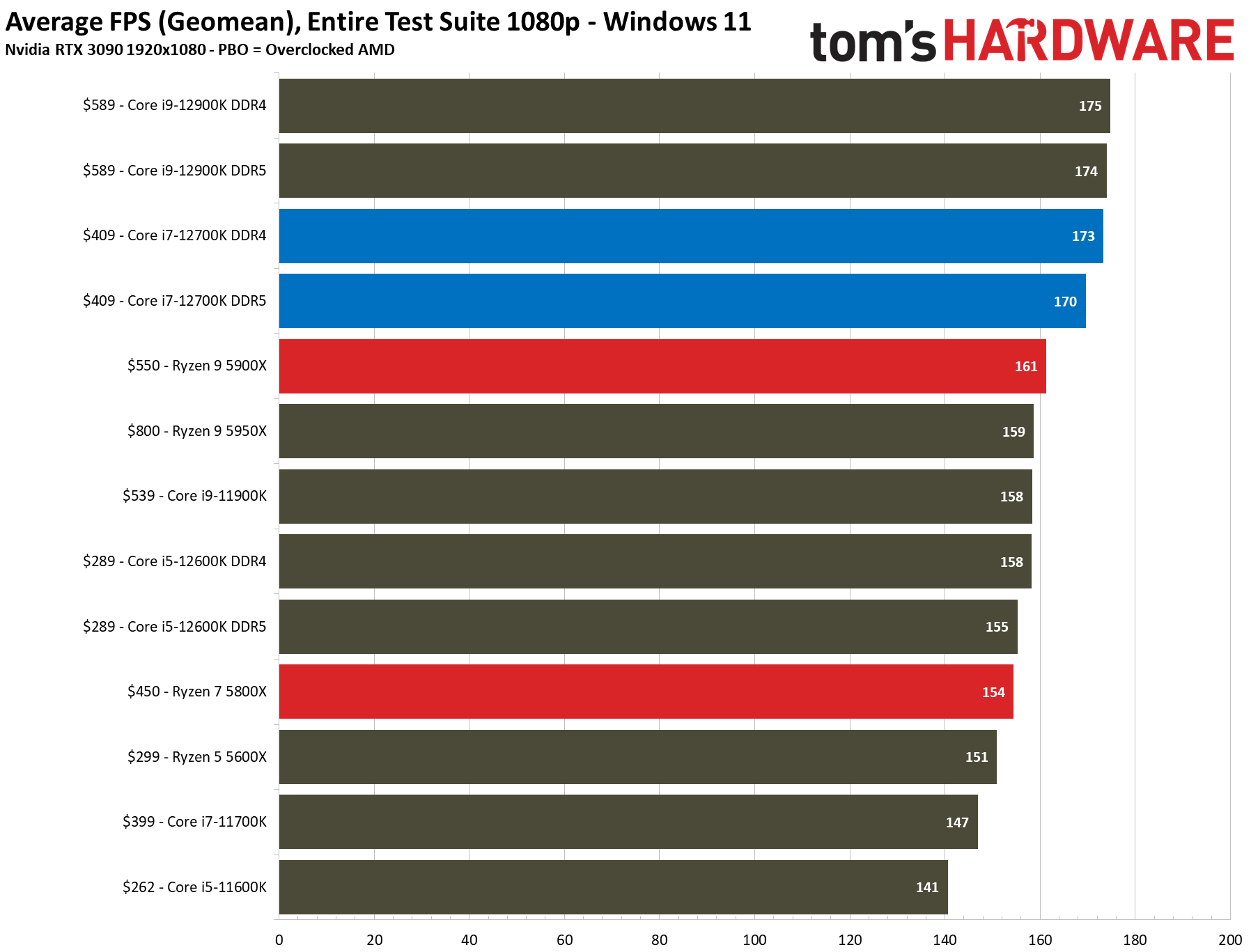
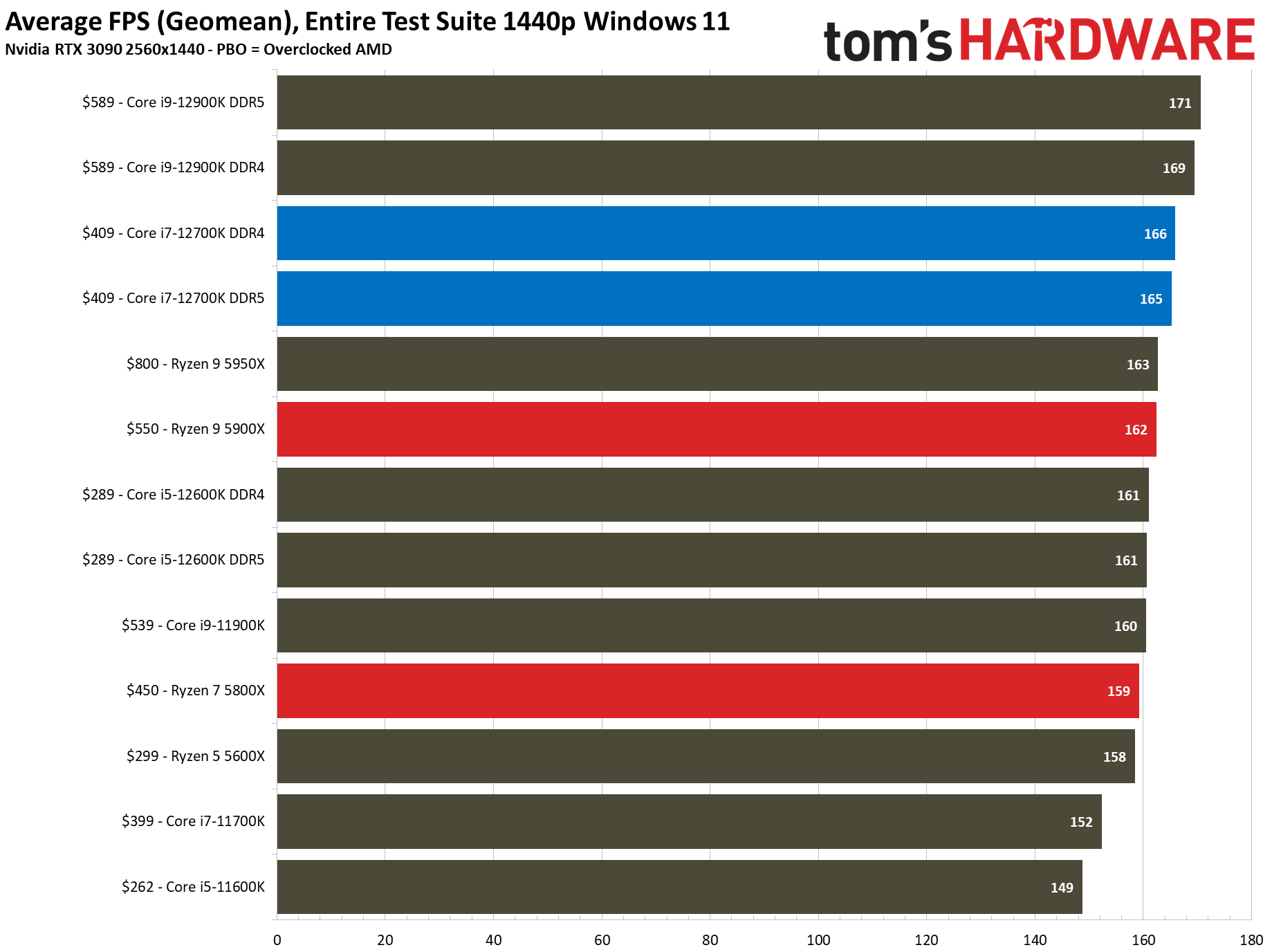
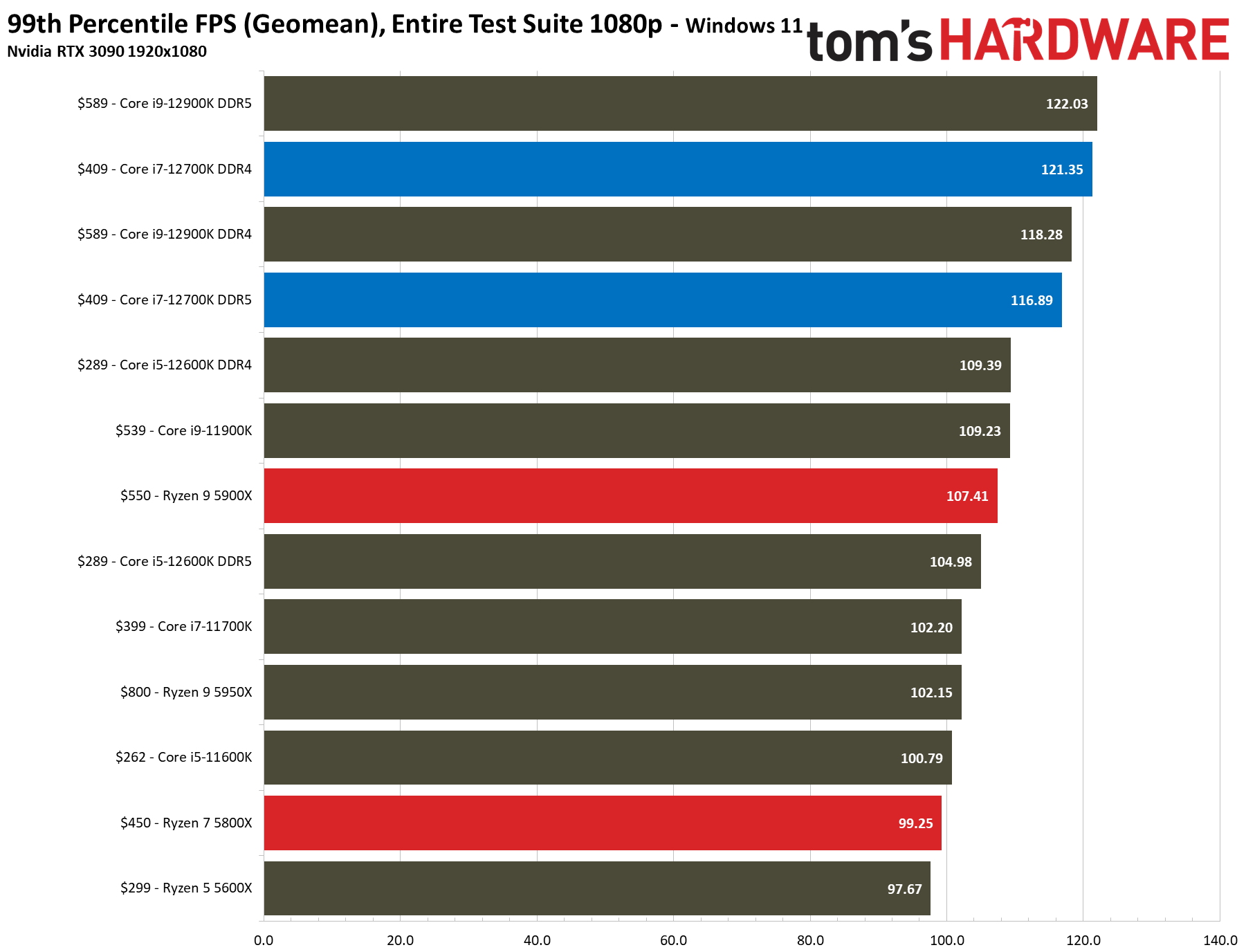
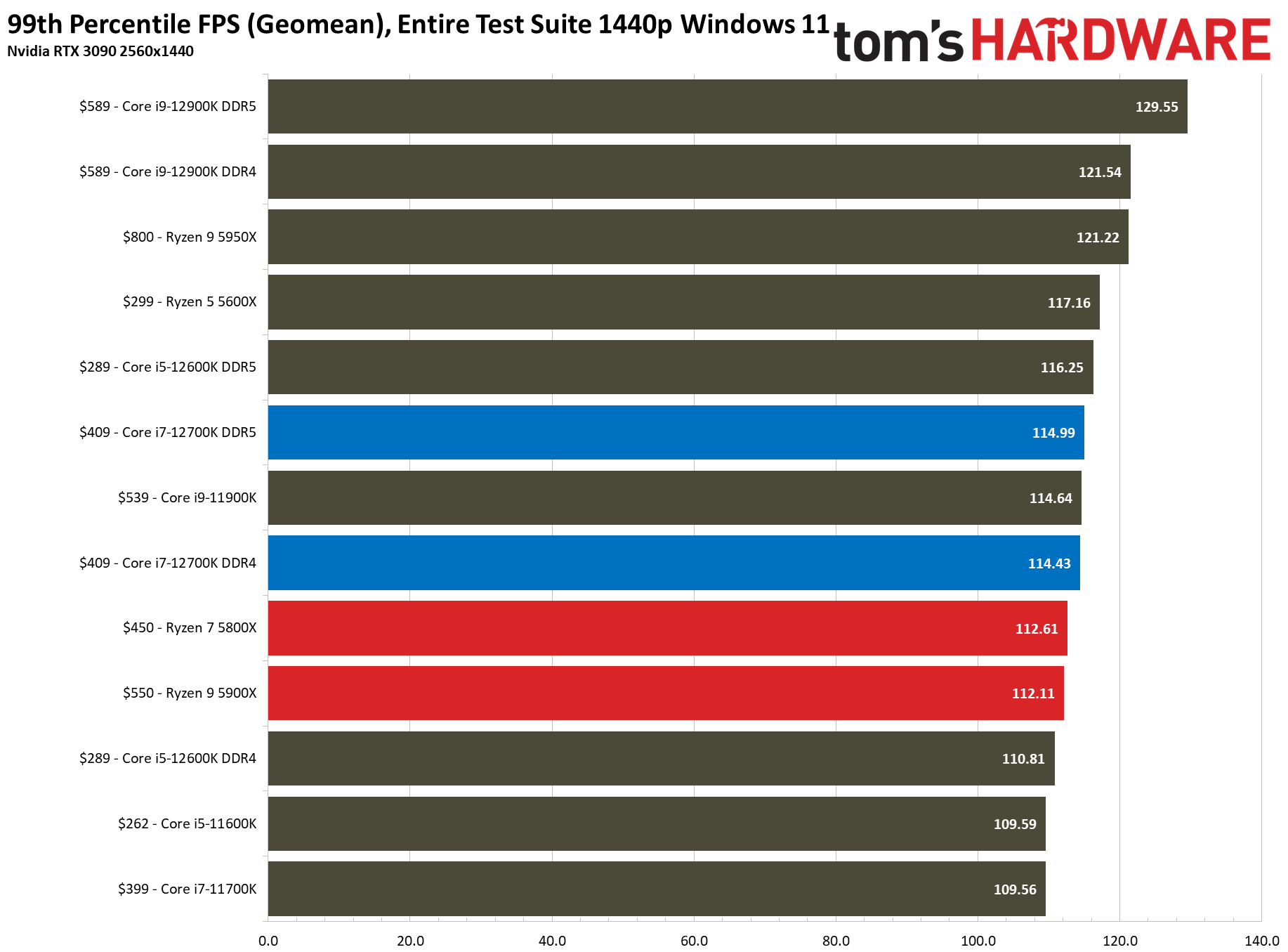




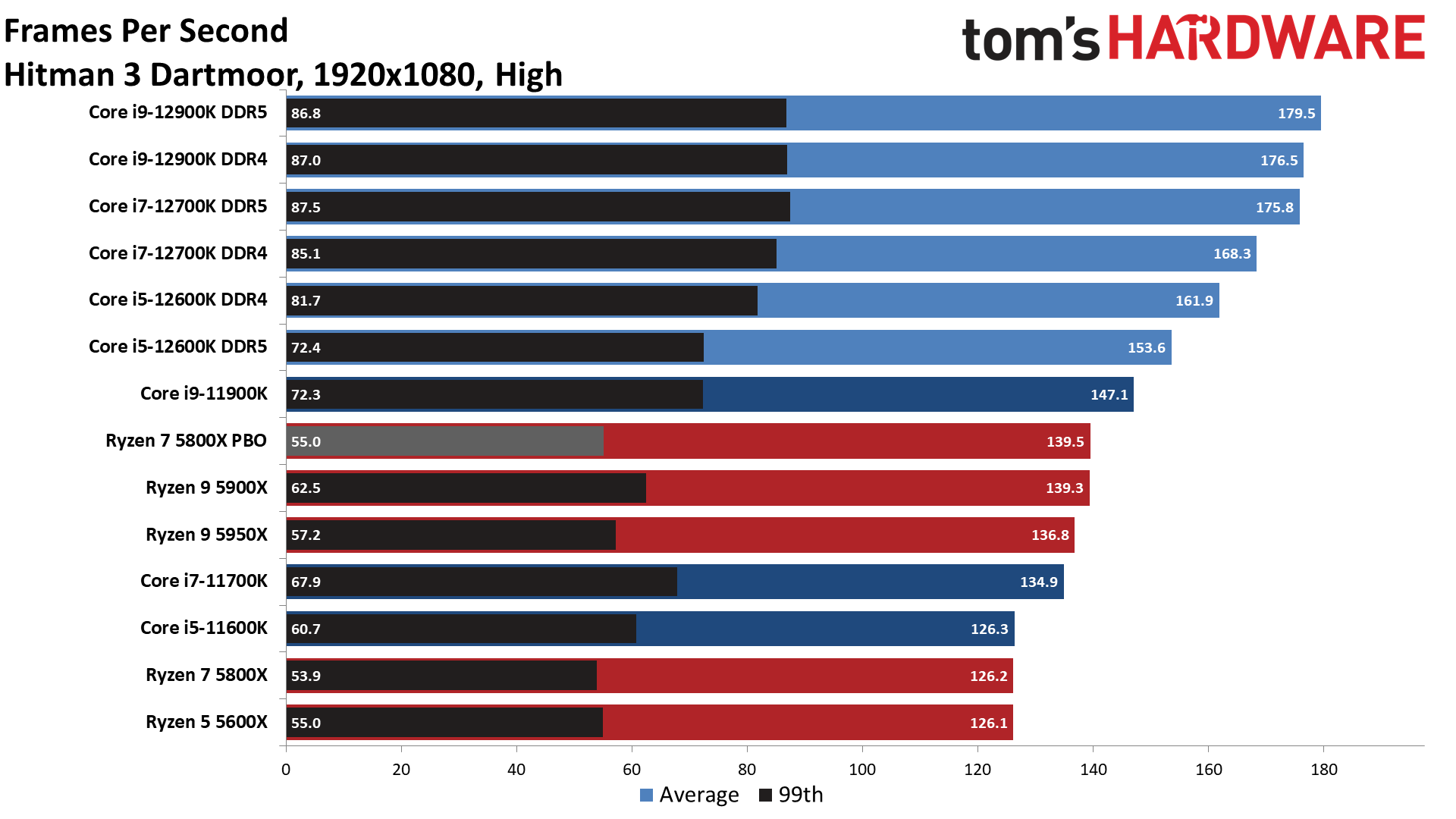
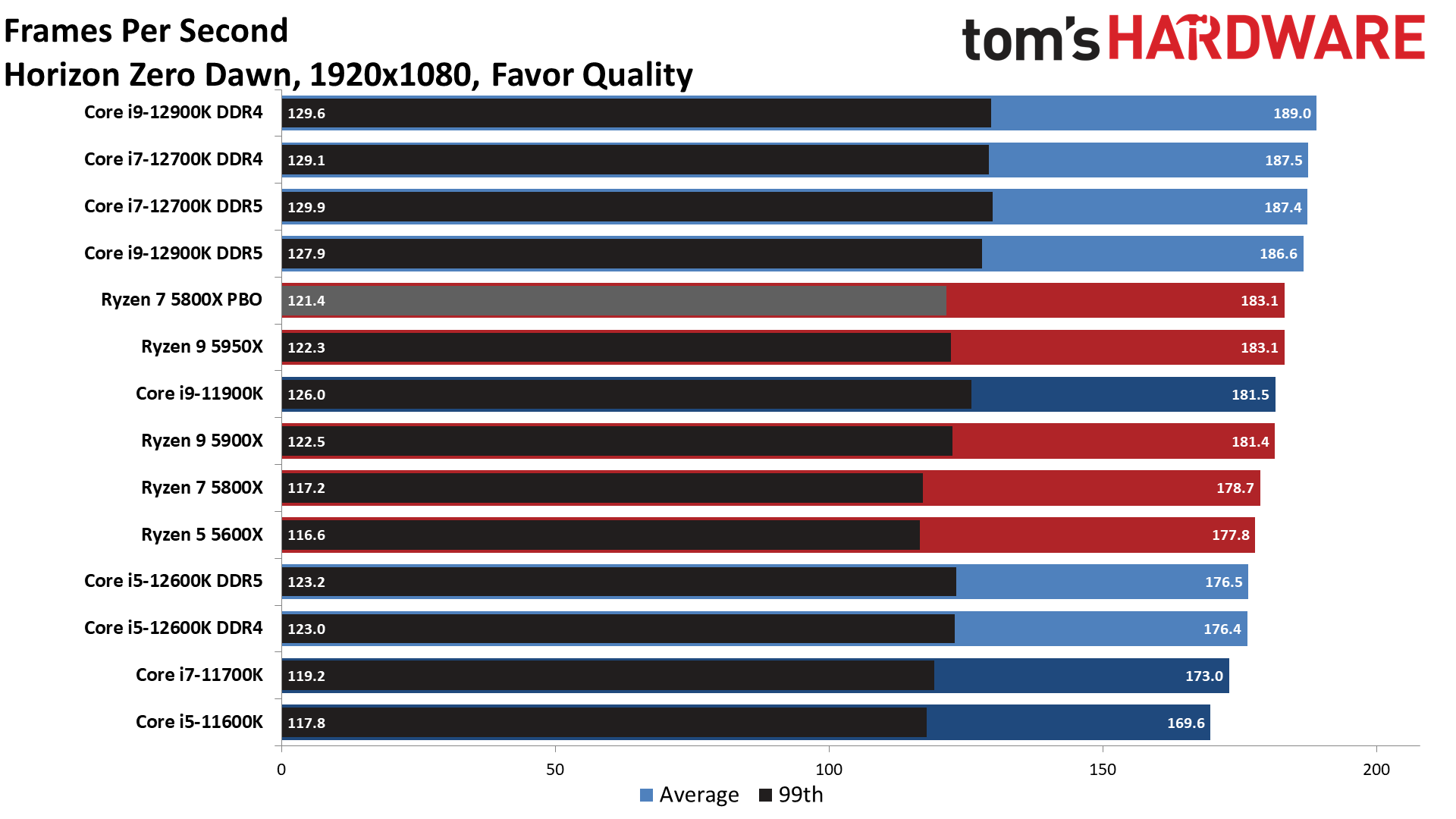

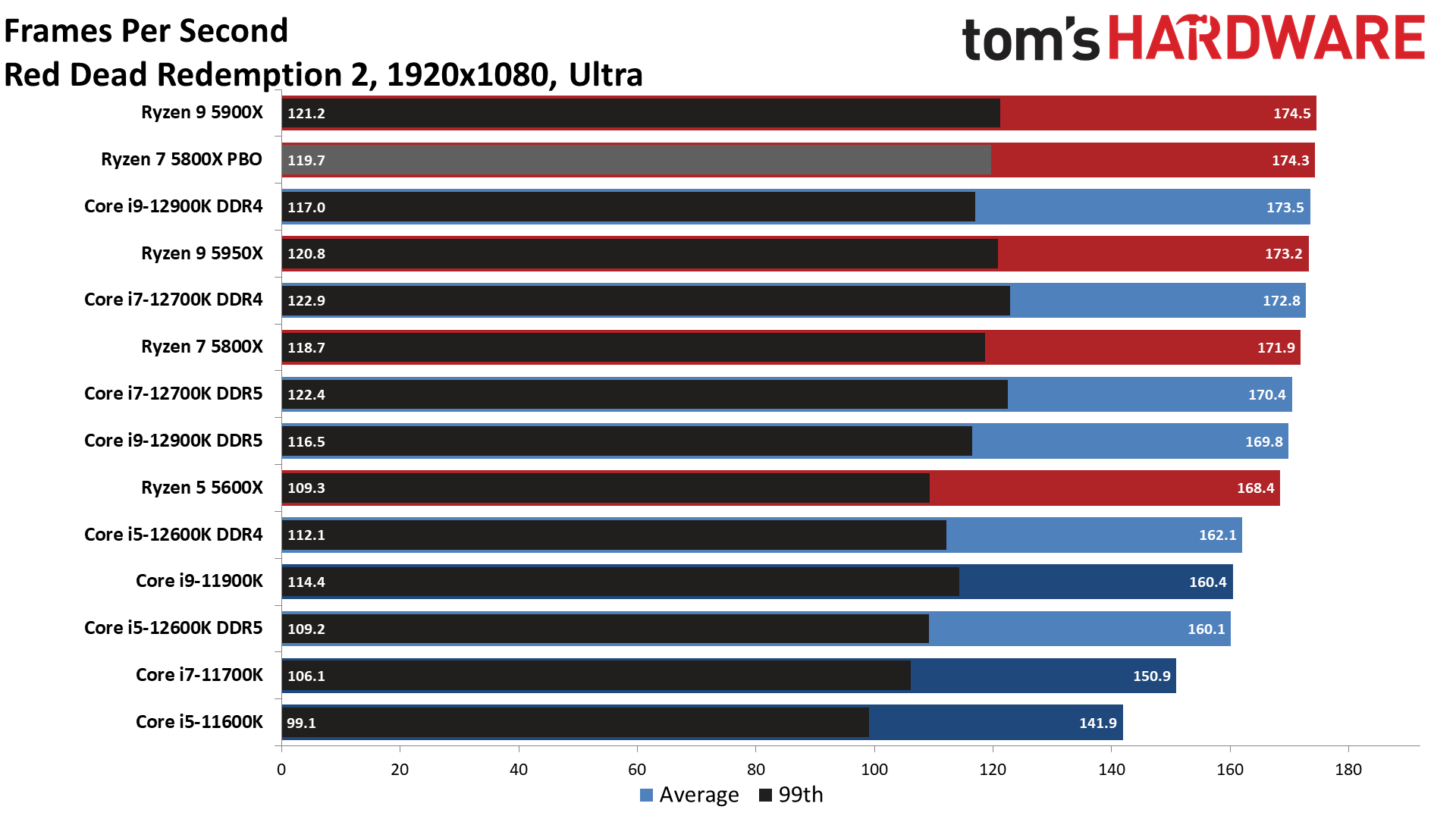



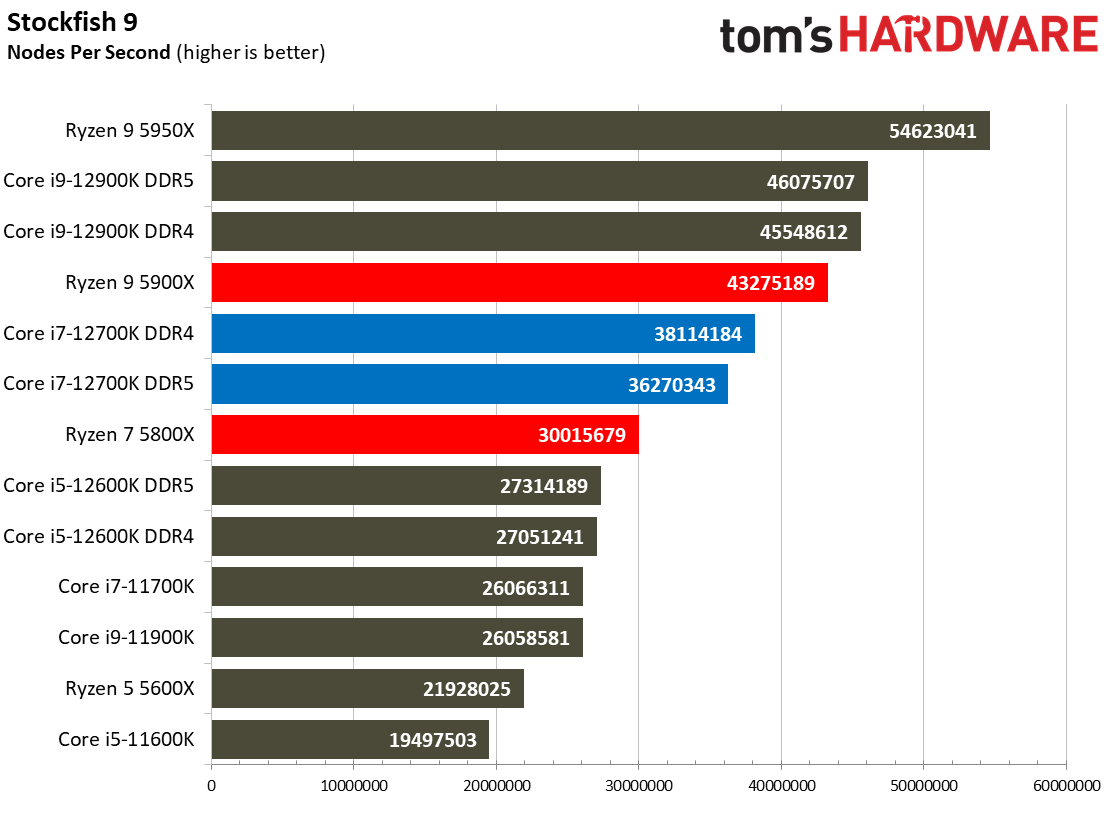
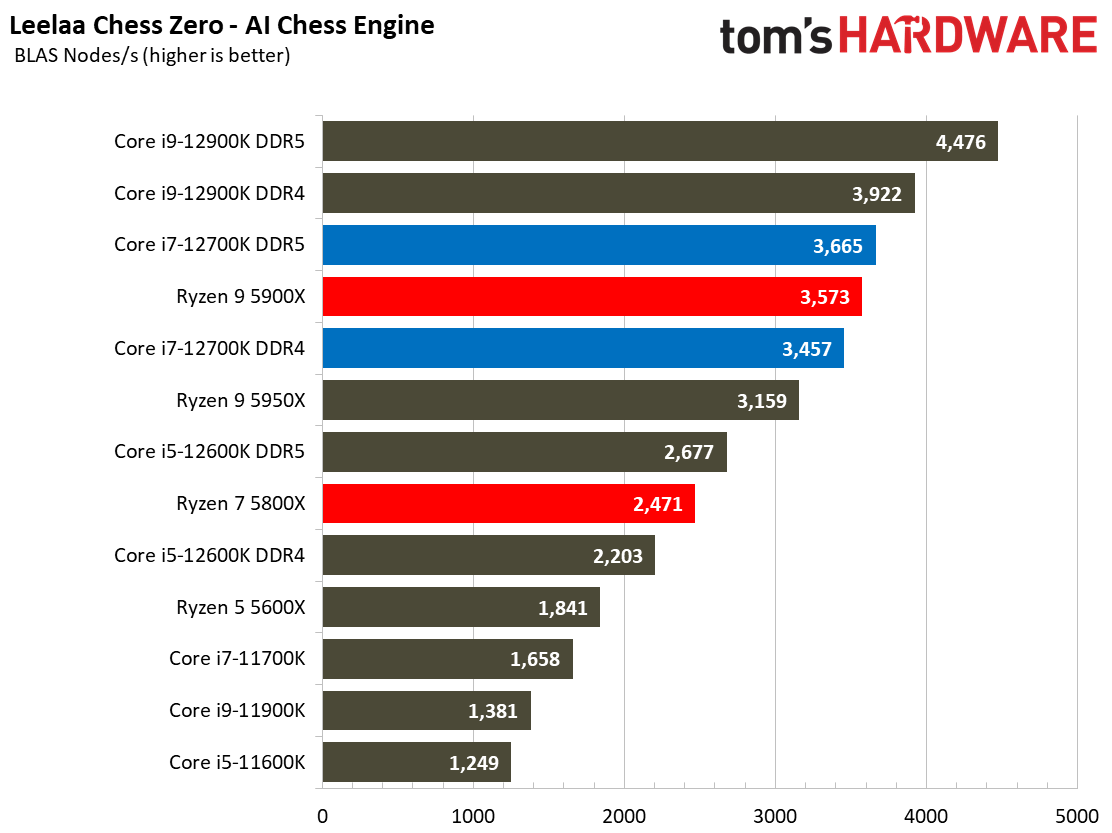
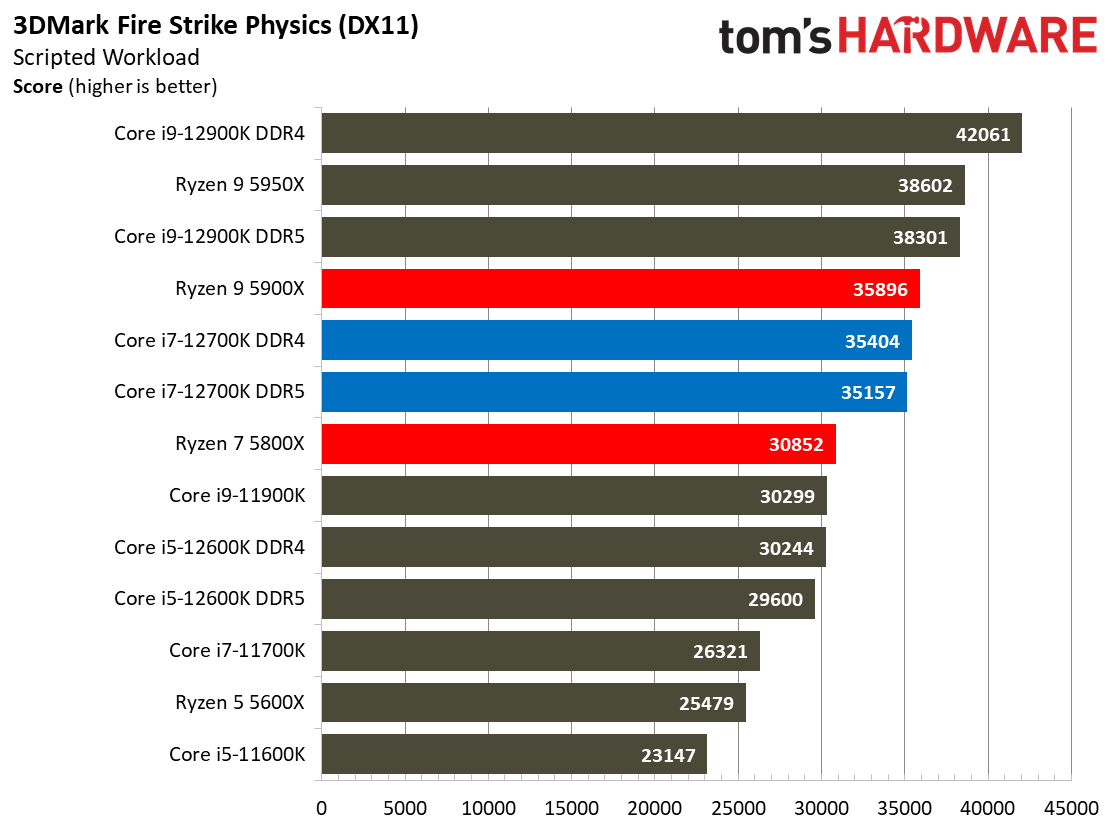


Paired with affordable DDR4 memory at the 1080p resolution, the $409 Core i7-12700K is 12% faster than the ~$390 Ryzen 7 5800X in our cumulative gaming performance measurement. The 12700K is also 7.5% faster than the $549 Ryzen 9 5900X that holds the title as AMD's fastest gaming chip.
Pairing the Core i7-12700K with DDR5 causes performance to decline, slightly reducing the leads to 10.4% over the 5800X and 5.5% over the 5900X at 1080p, but we have to keep things in perspective — that's only a 3 fps difference between the DDR4 and DDR5 setups. It's clear that you don't need an expensive DDR5 kit or motherboard to extract the best of the 12700K's performance, especially given the markup for a DDR5-capable motherboard and the scalper pricing on DDR5 kits.
The Core i7-12700K is plenty impressive against AMD's chips, but it really stands out when we compare it to Intel's flagship $589 Core i9-12900K: The difference between the two chips is in the noise of expected run-to-run variance. That means the 12700K delivers a 12900K-class gaming experience, but for $180 less. Notably, the 12900K will have a bit more heft for background tasks like streaming due to its additional four E-cores, and perhaps a bit more gas in the tank for future GPU upgrades due to its 200 MHz higher boost clock.
Naturally, moving over to 1440p pushes the bottleneck to the GPU, so the difference between the chips shrinks tremendously. Gamers with lower-resolution panels with high refresh rates will benefit more from Alder Lake's faster frame rates. Flipping through the 99th percentile charts shows larger deltas between the chips, but Windows 11 is still a bit raw and seems to suffer from more framerate variability than Windows 10.
The AMD vs Intel gaming competition is closer now, with some games favoring one architecture over the other. As such, it's best to make an informed decision based on the types of games that you play frequently. Be sure to check out the individual tests in the above album. In either case, Intel holds the lead.
Winner: Intel
The Core i7-12700K beat the Ryzen 7 5800X by substantial amounts in our Windows 11 testing, and though the lead narrowed against the Ryzen 9 5900X, it still led by ~7%, but for $150 less. Overall, you get the 12900K gaming experience, but for significantly less cash, which is hard to beat. You can head to our CPU Benchmark hierarchy to see comparisons in Windows 10, but the deltas are similar, giving the 12700K the win in this category.
Of note: The Denuvo DRM falsely identified Intel's E-cores as a separate system, and thus ~20 Denuvo-enabled game titles currently don't work with Alder Lake chips. You can read about the simple fix and find the impacted games here. Denuvo says that all affected games will be patched soon.
Application Performance: Intel Core i7-12700K vs Ryzen 9 5900X and Ryzen 7 5800X
We're focusing on Windows 11 application test results for this article, but be aware that we encountered subpar performance in Windows 10 with some of the programs that worked perfectly in Windows 11. These problems arise due to a lack of software optimizations for hybrid architectures.
There are methods to correct those issues in Windows 10, but it could require some manual adjustment until more patches arrive from software vendors. Aside from the odd performance in the Handbrake x264, y-cruncher, Corona, and POV-Ray tests, our comparative Windows 10 performance results largely mirrored what we see in Windows 11. Head to our review for more detailed information.
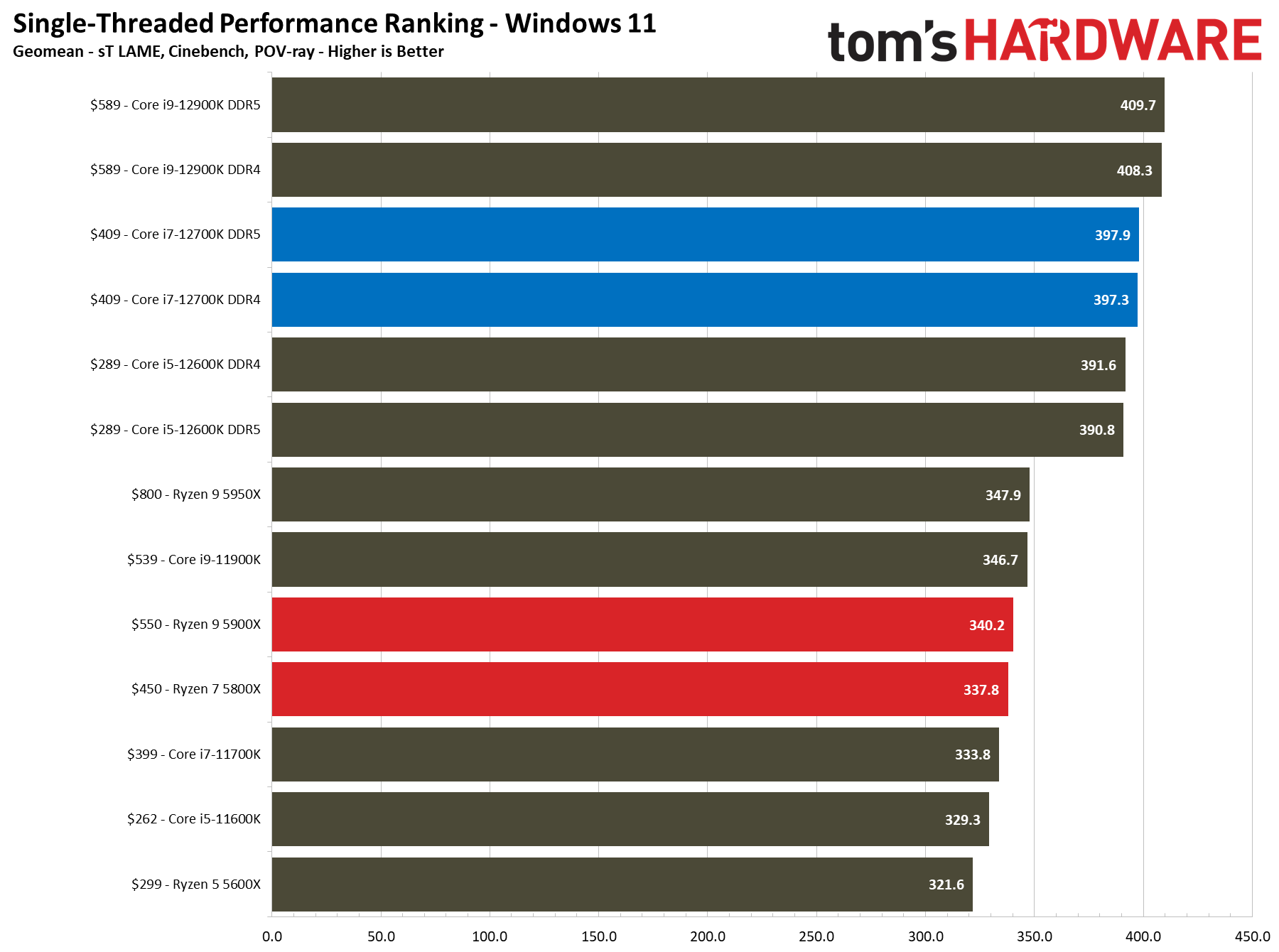
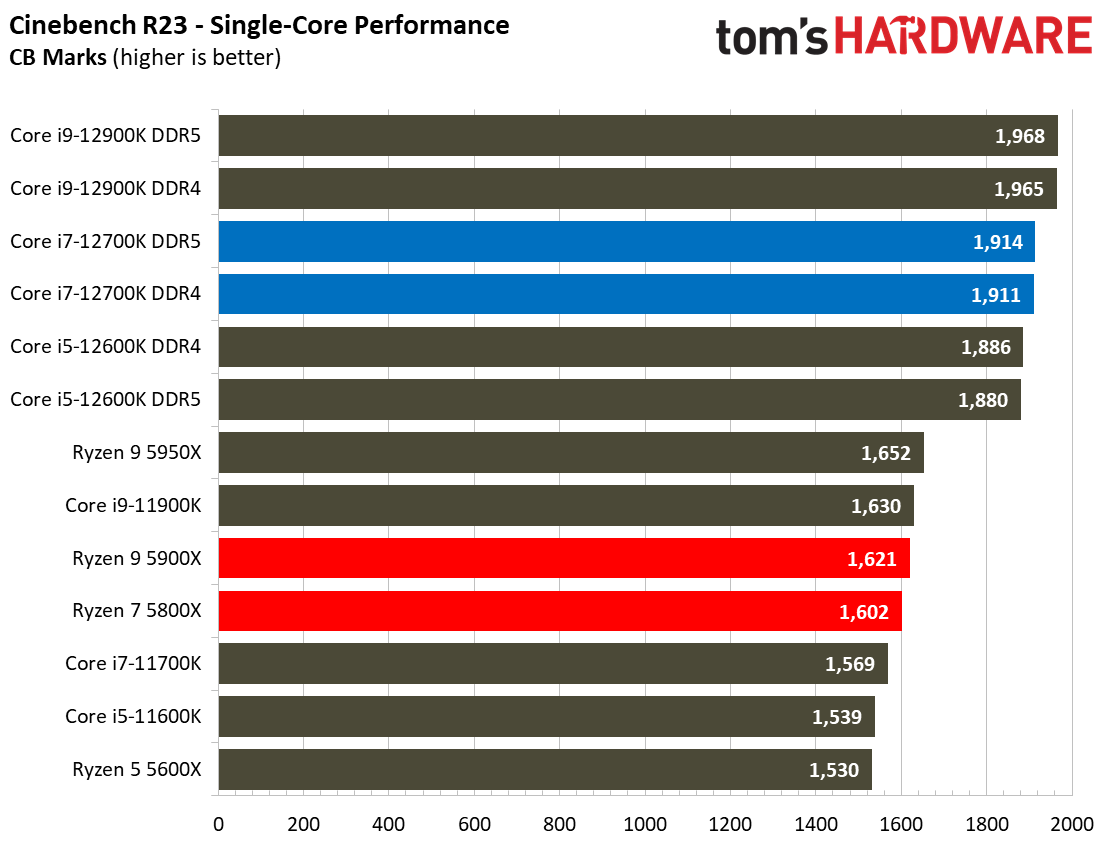
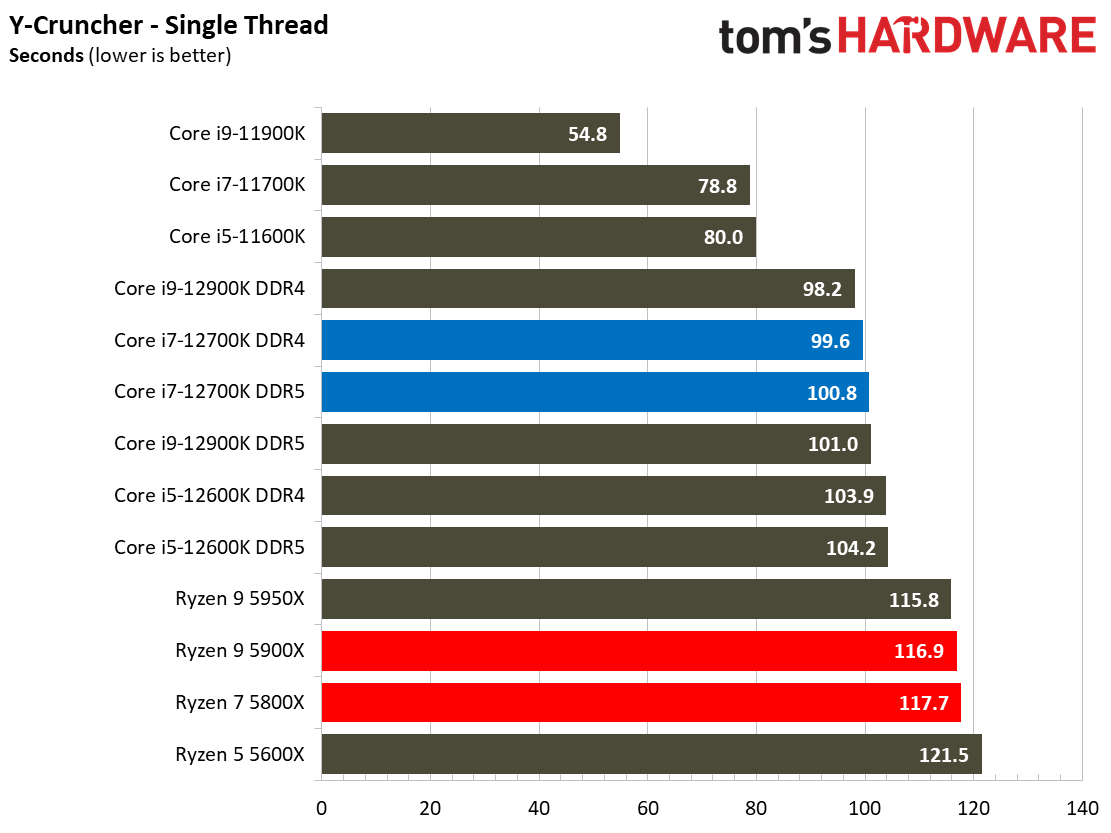

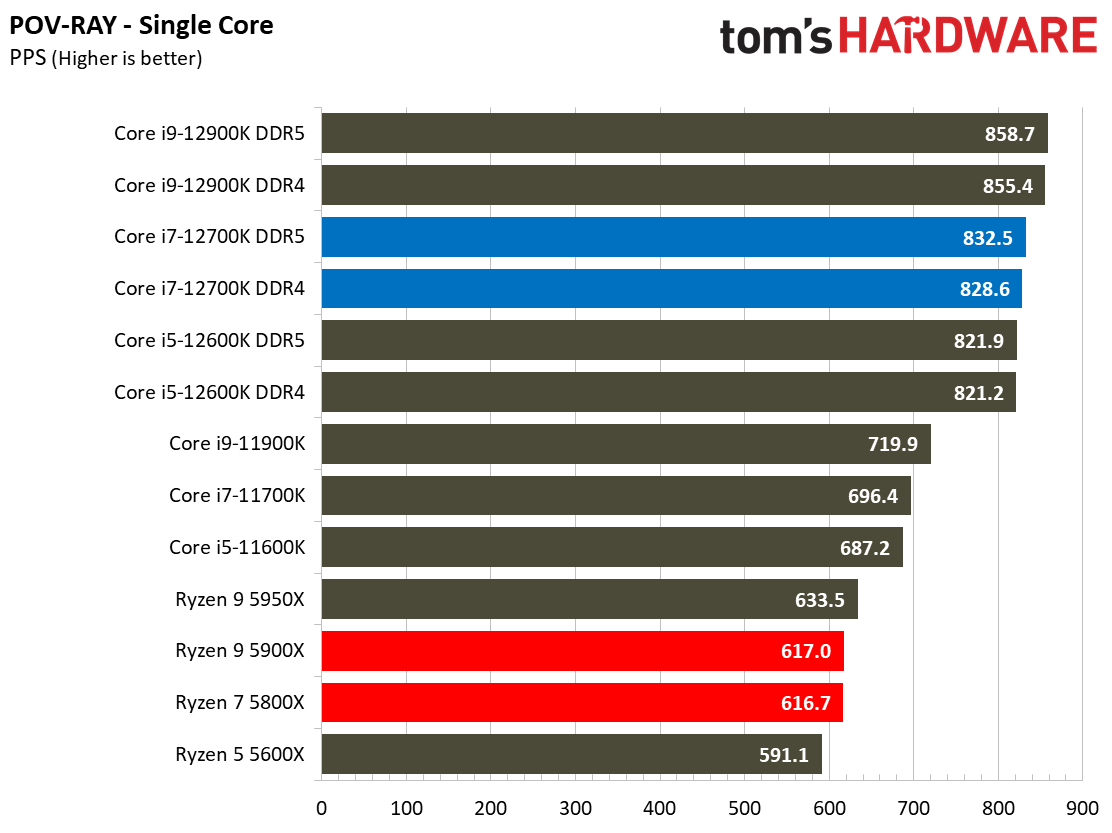

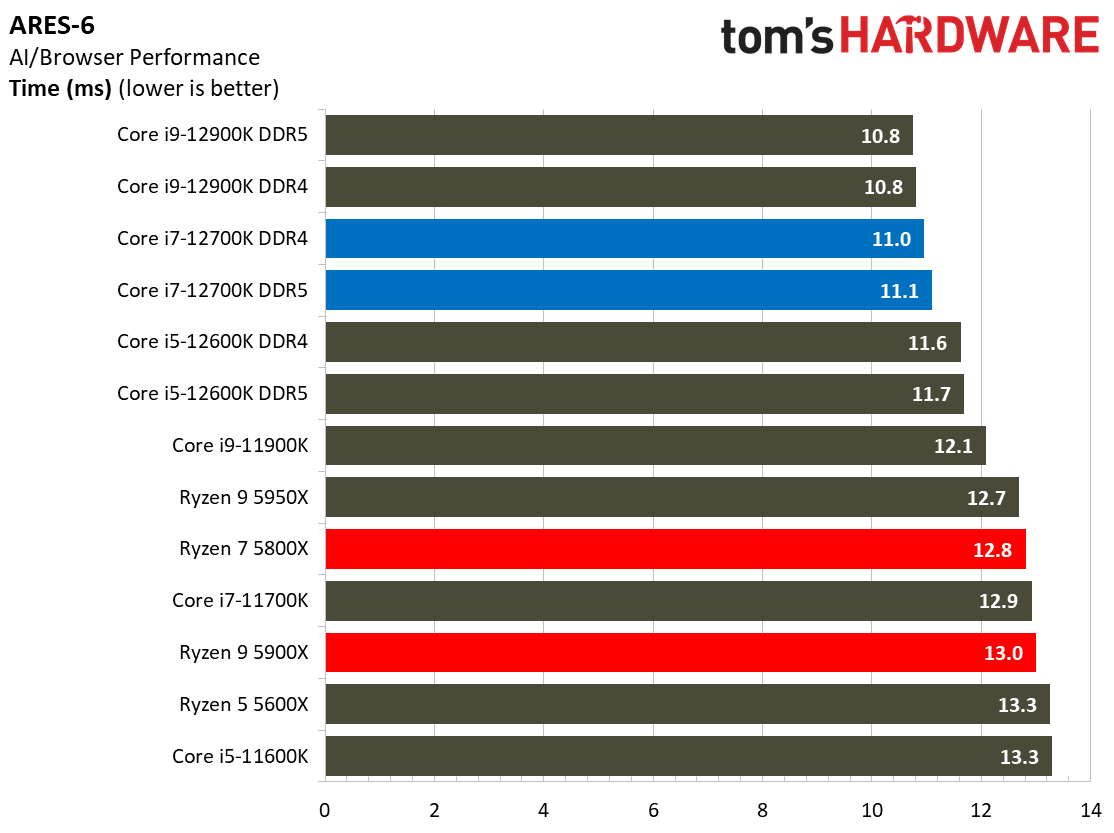
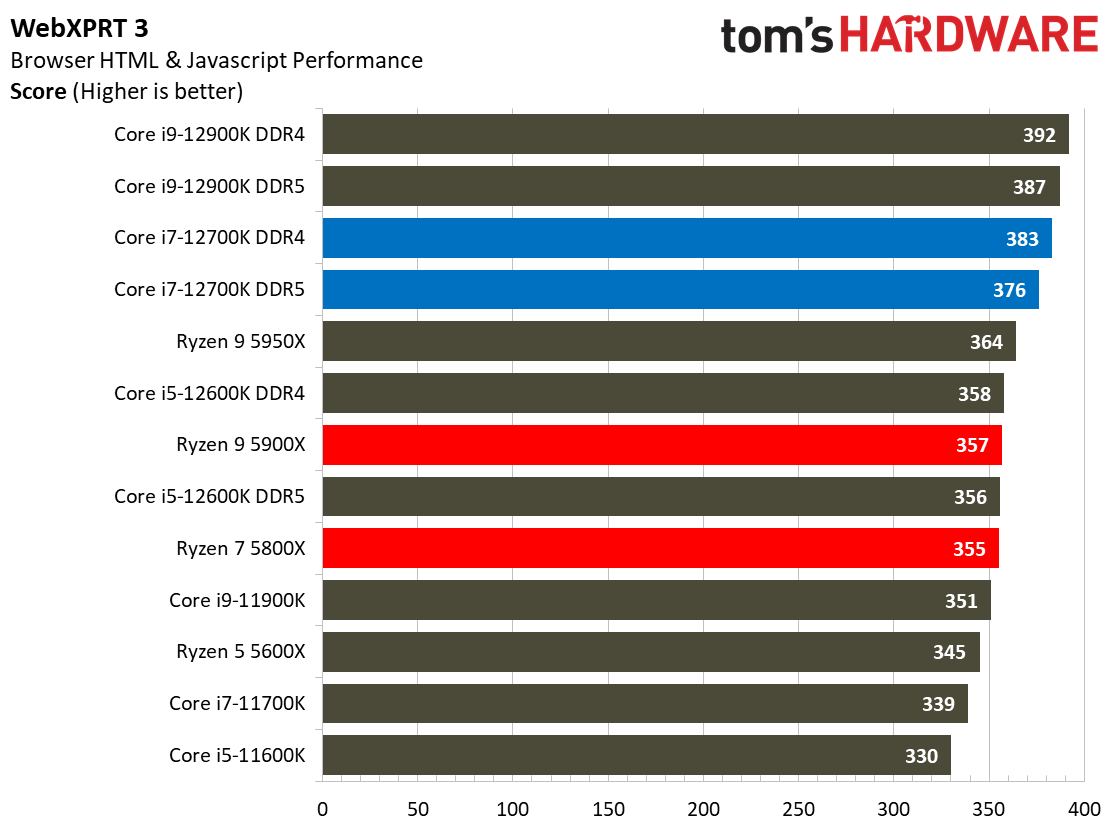

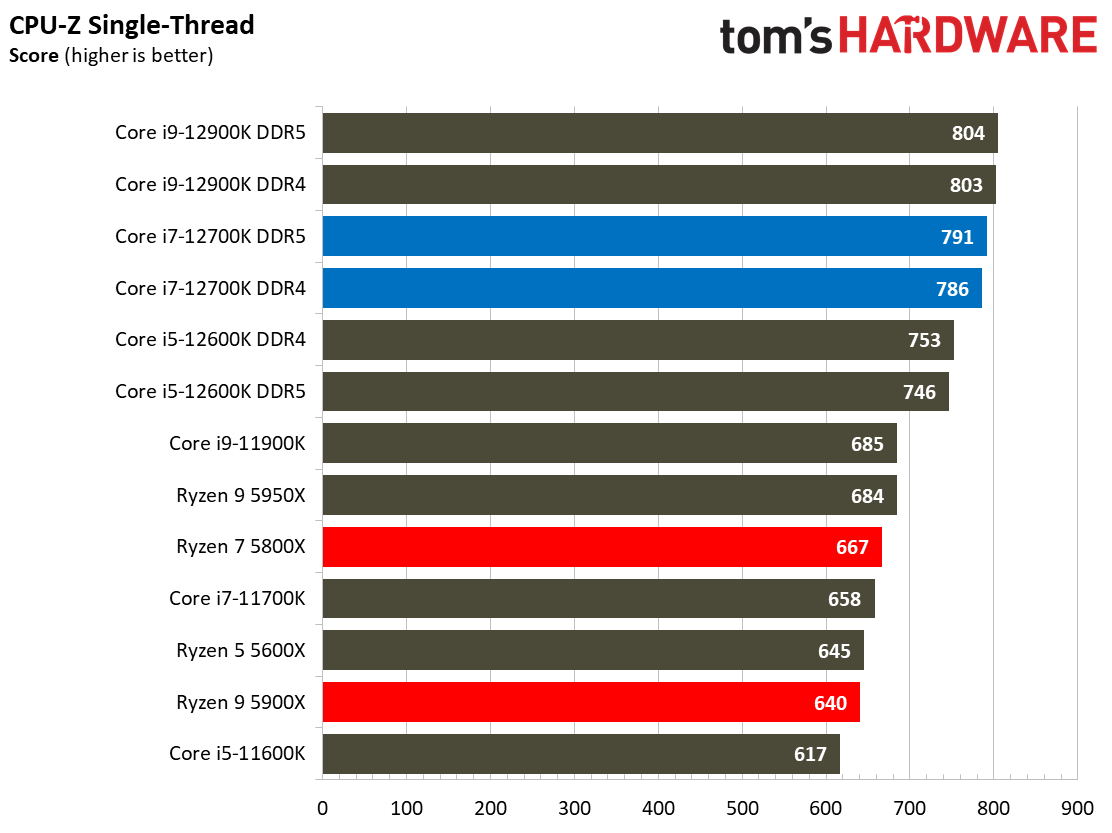
We can boil down productivity application performance into two broad categories: single- and multi-threaded. The first slide above shows the geometric mean of performance in several of our most important tests in each category, but be sure to look at the expanded results below.
The Core i7-12700K is ~17% faster than the Ryzen 7 5800X and Ryzen 9 5900X in the single-threaded tasks listed in the chart title. Naturally, those impressive performance deltas won't carry over to every type of workload, but the 12700K beats the Ryzen lineup in every benchmark. In single-threaded work, the 12700K is 19% faster than the previous-gen 11700K and 14% faster than the previous-gen flagship 11900K. The 12900K is the only chip on the market that can beat the 12700K in lightly-threaded work, though only by a comparatively slim 3% margin.
These high levels of performance in lightly-threaded apps will equate to a snappier, faster experience in all manner of light day-to-day tasks. The 12700K's snappy performance will be most perceivable in web browsers and application start-up tasks.
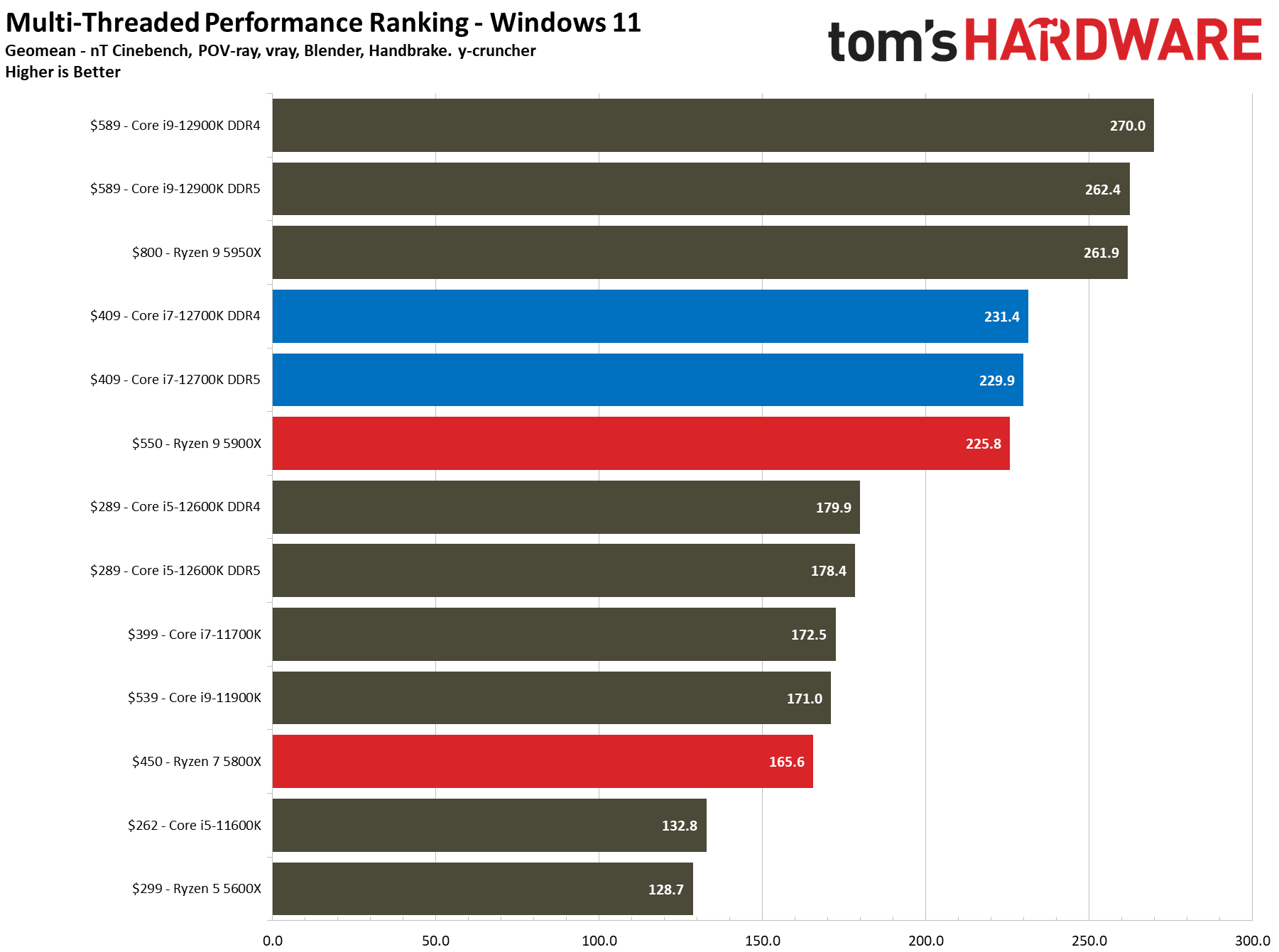
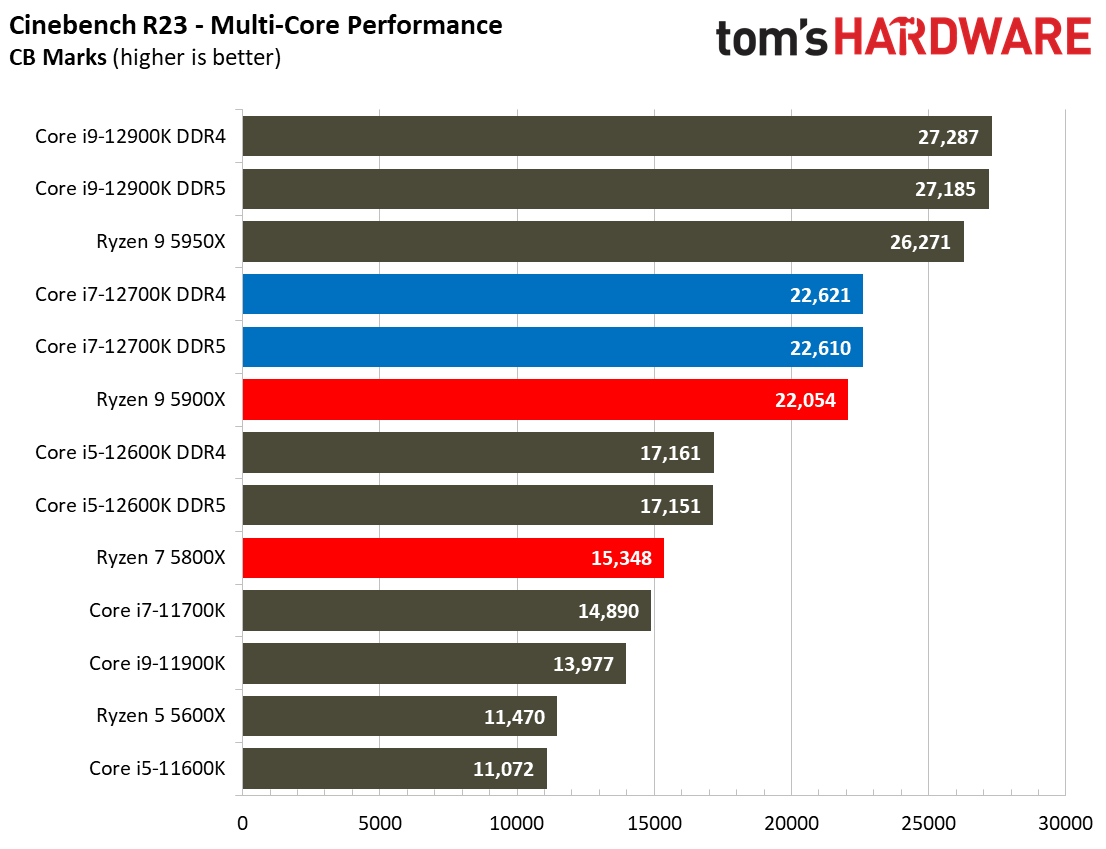


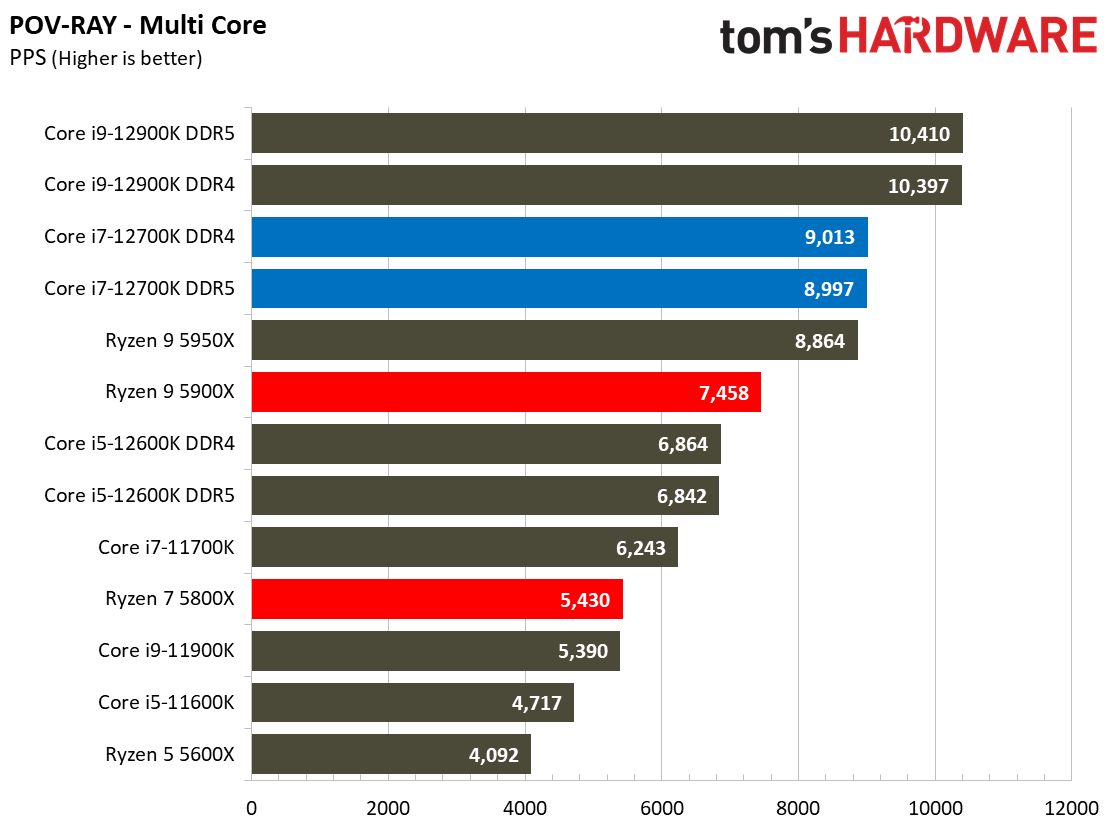




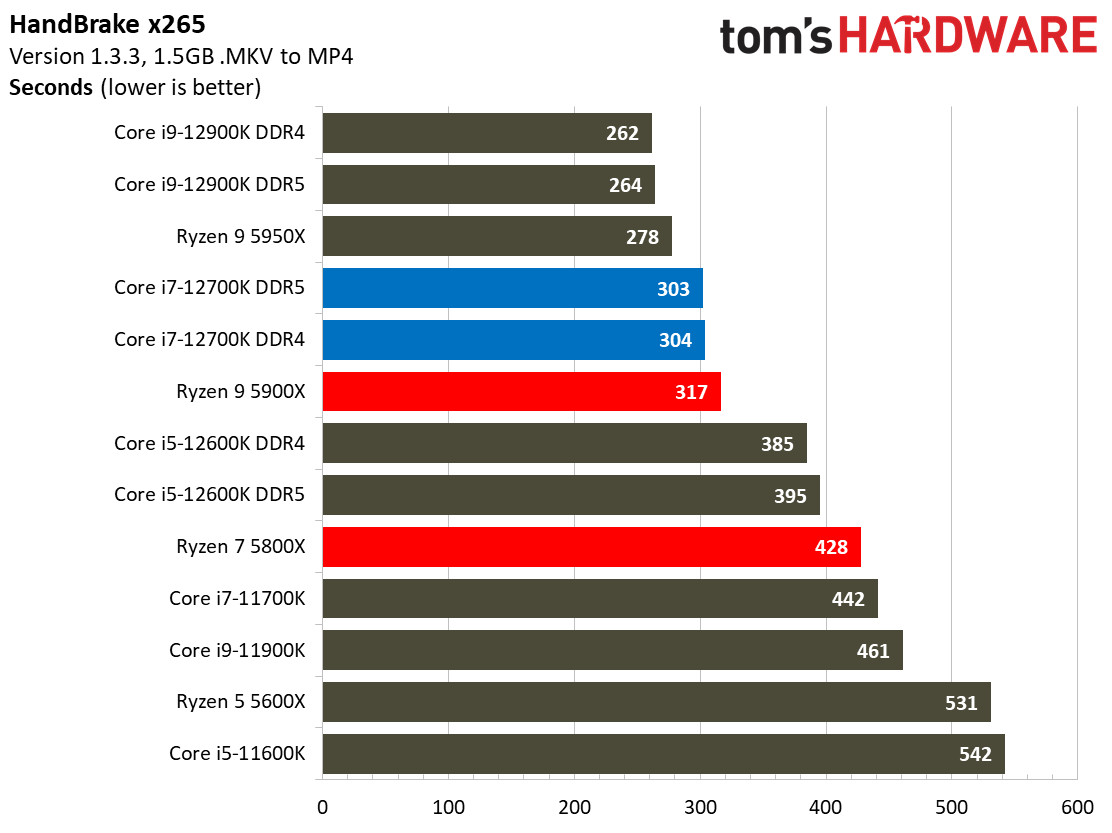
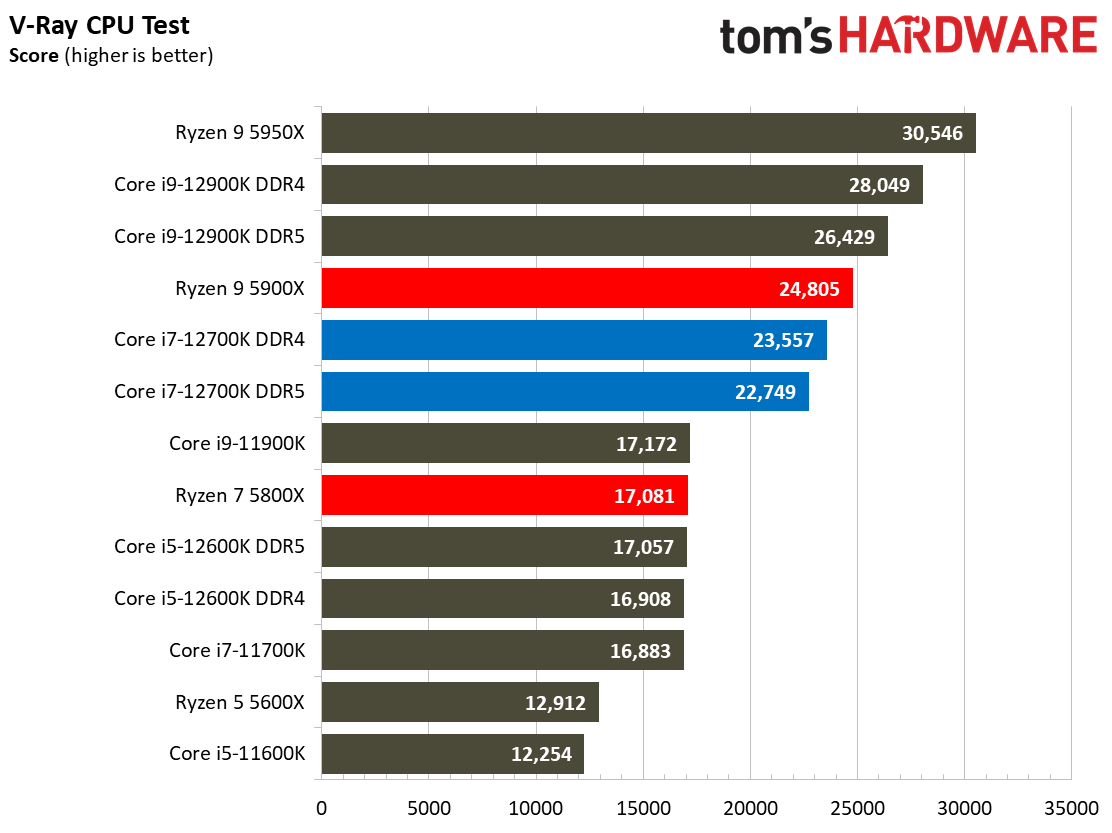
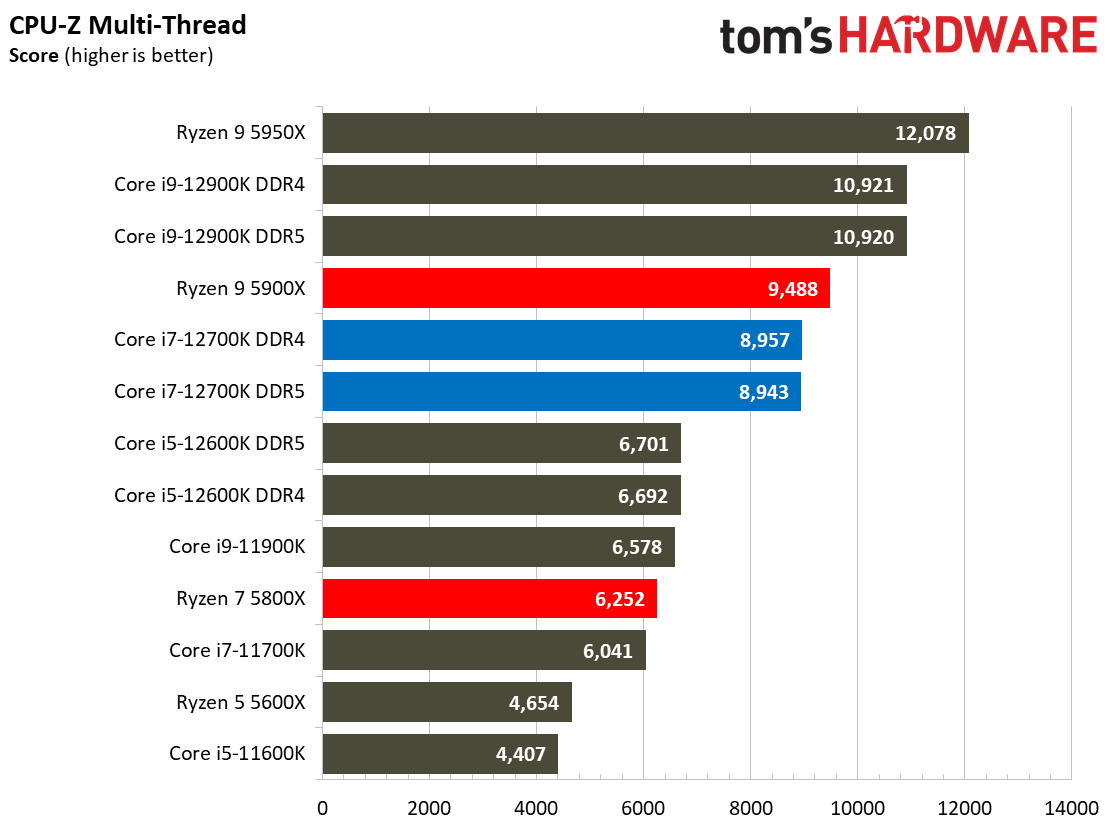
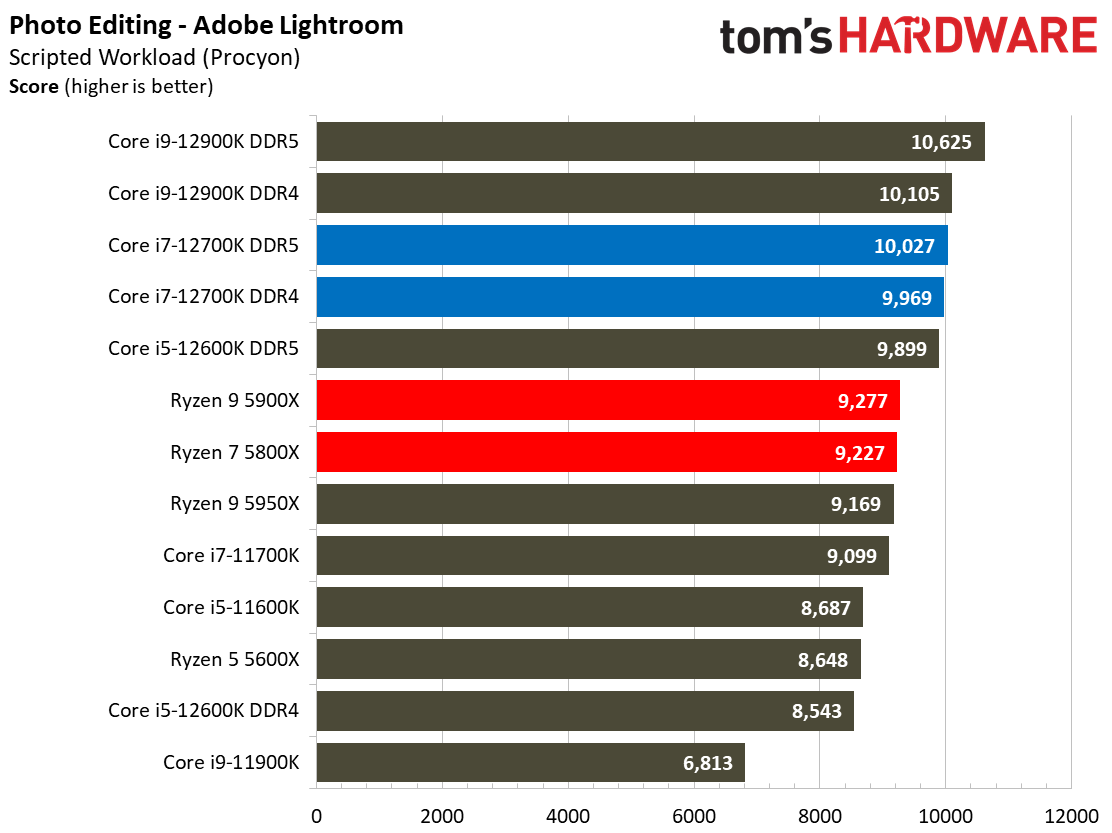



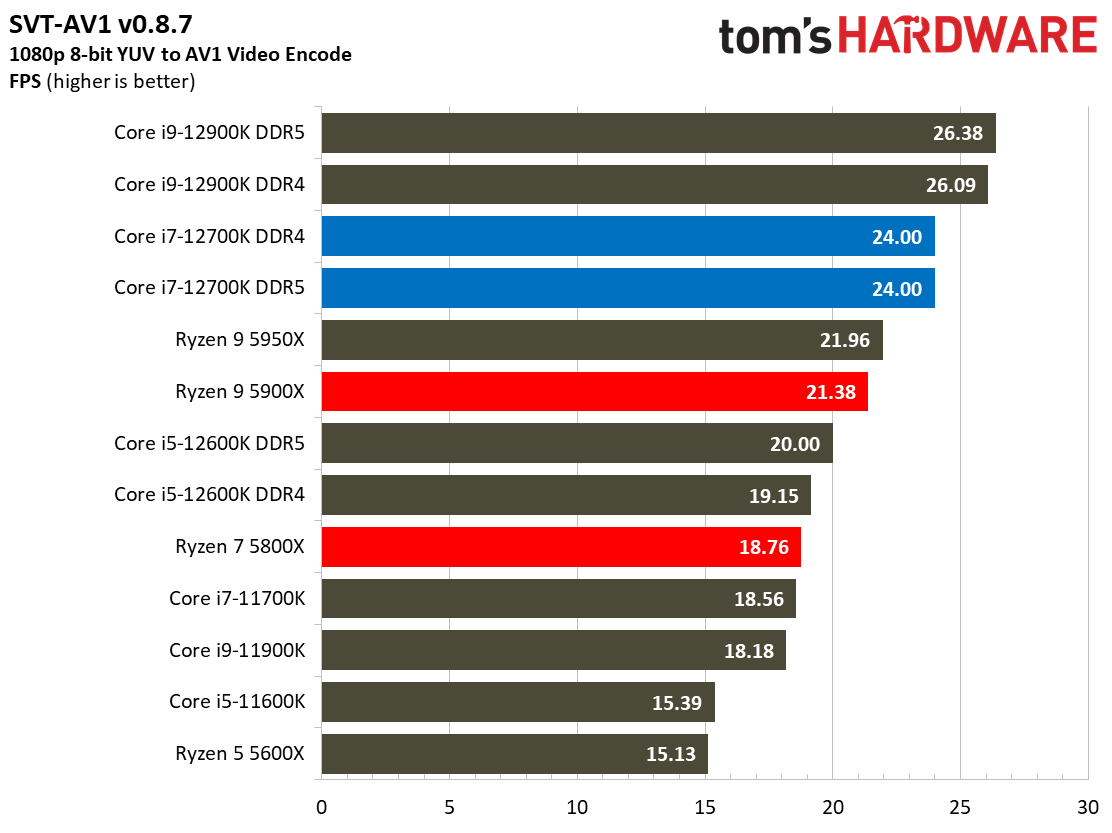

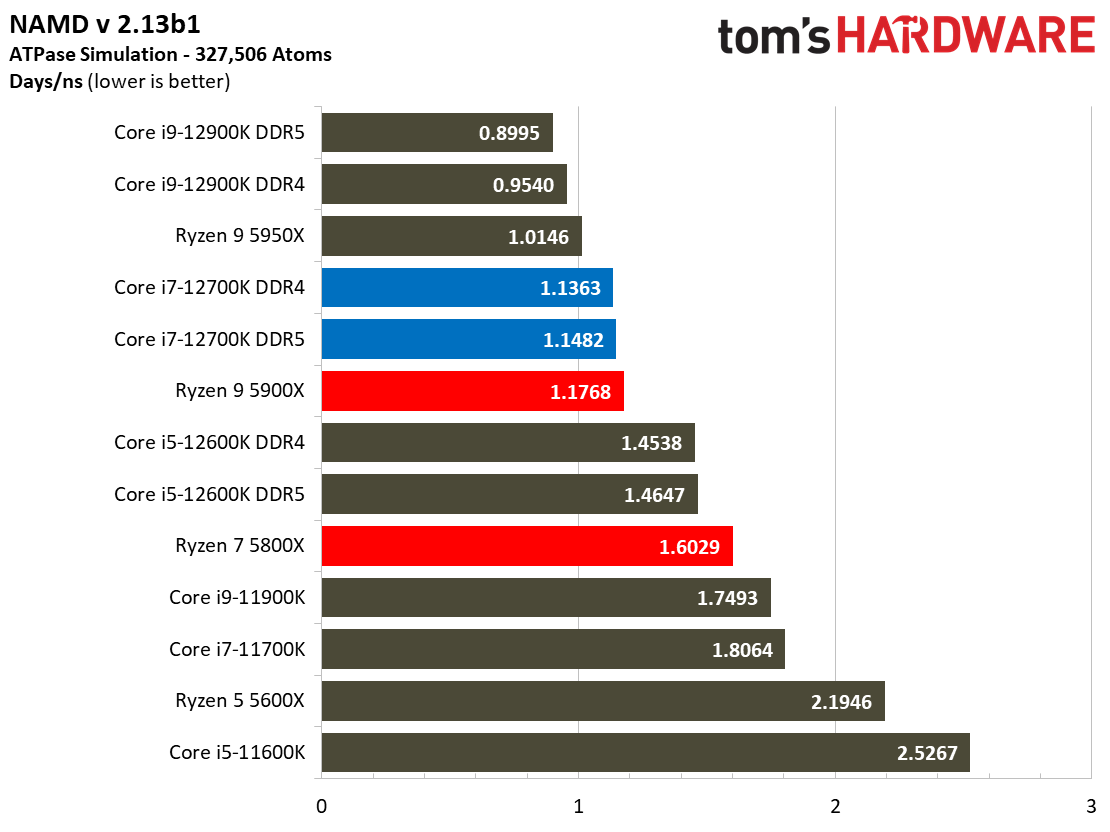
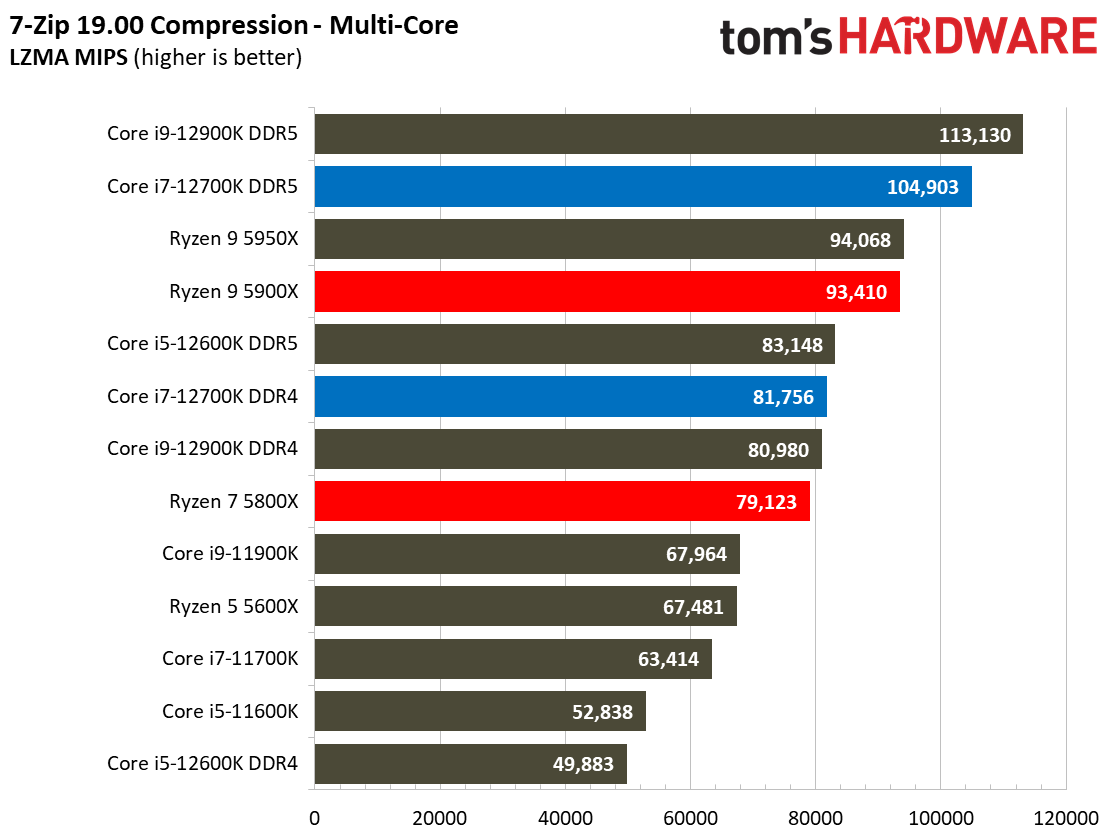
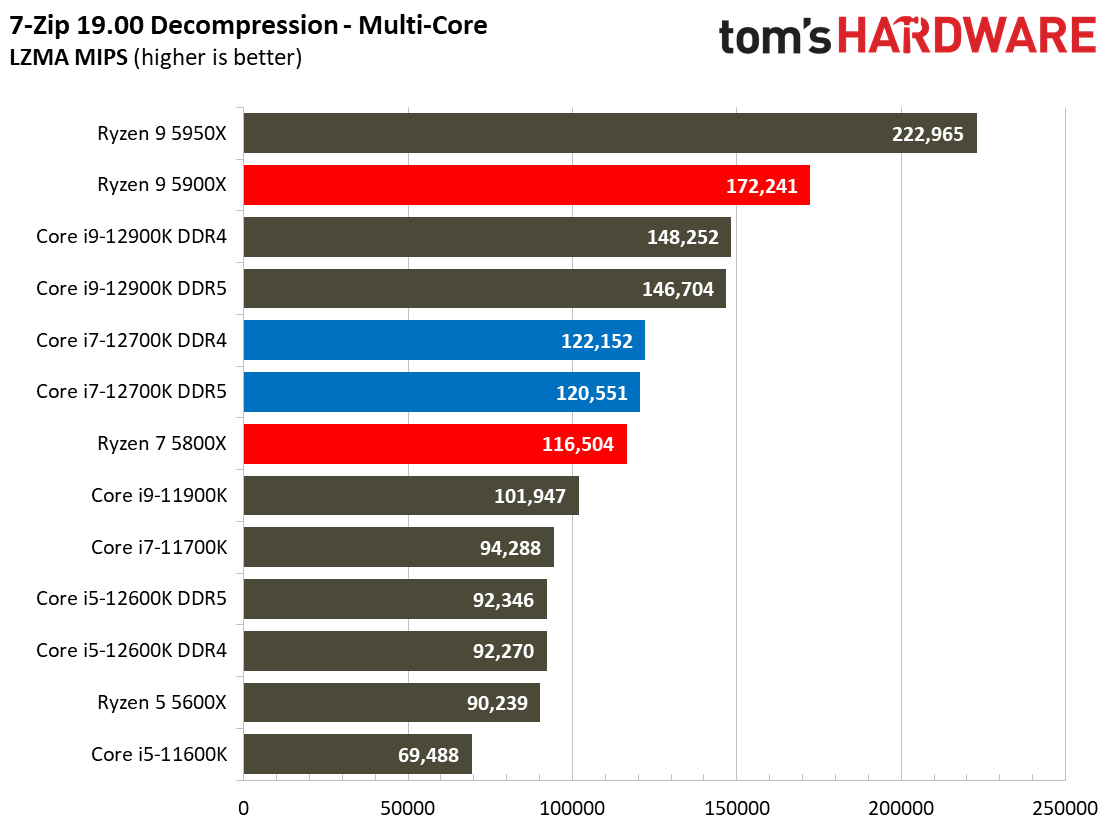
In our cumulative measurement, the 12-core 24-thread Core i7-12700K is 2.5% faster than the 12-core 24-thread Ryzen 9 5900X in threaded work. It's also 40% faster than the Ryzen 7 5800X. The generational uplift is impressive, too. Against the previous-gen flagship 11900K, the 12700K is 35% faster in heavily-threaded tasks and 34% faster than the 11700K.
The current-gen 12900K is ~17% faster in threaded work than the 12700K, justifying the premium for users that are focused on productivity work. However, it's quite impressive to see the 12700K remain this competitive with the 12900K, especially because the difference between the two largely boils down to higher boost clocks and four fewer E-cores for the 12700K. Despite that disparity, the 12700K puts up strong results in applications with branchy code like LLVM compilation and the massively parallel molecular dynamics simulation code in NAMD. These heavily-parallelized high-throughput applications respond very well to the E-cores, giving the 12900K a leg up.
Given its more forgiving price tag, the 12700K also shines in more standard fare, like threaded encoding tasks, like Handbrake x264 and x265, SVT-HEVC, and SVT-AV1.
Winner: Intel
The $409 Core i7-12700K beats the Ryzen competition in every single-threaded benchmark, so it delivers exceedingly snappy performance in many of the lighter applications, like web browsers and office applications. At its price point, the 12700K is untouchable in lightly-threaded work — the $589 Core i9-12900K is the only chip on the market that can beat the 12700K in this type of work.
The 12700K beat the Ryzen 7 5800X in every multi-threaded workload — it really wasn't much of a contest. The Ryzen 9 5900X is much more competitive here, with the 12700K only being 2.5% faster in our cumulative measurement. However, the 5900X carves out quite a few wins in specific applications, like Blender.
The Core i7-12700K wins this round due to its compelling blend of both single-and multi-threaded performance and its more forgiving price tag.
Notably, like the other Alder Lake chips, the Core i7-12700K can suffer in some multi-threaded workloads in Windows 10 due to difficulties with code with certain prioritization settings. You can correct those issues either via command-line utilities or third-party software, like Process Lasso, and receive the full expected performance. We expect the industry to correct many of those issues over time. Still, it is important to know that Windows 10 could require additional manual tuning to extract the utmost performance.
Overclocking: Intel Core i7-12700K vs Ryzen 9 5900X and Ryzen 7 5800X
Overclocking has become much more complex with the addition of a myriad of new knobs to turn, and much of that has to do with the shrinking frequency headroom. Due to fierce competition, both Intel and AMD have rolled more of their frequency headroom right into the stock settings over the last few years. Luckily for mid-range system builders, you tend to find the most headroom in the lower- to mid-range parts. Enthusiasts have also turned to wringing out extra performance from memory and fabrics as the companies expose more tuning knobs.
Both Intel and AMD expose a wealth of tunable parameters, along with sophisticated software overclocking utilities like XTU and Ryzen Master. Both companies also support per-core frequency and hyper-threading control (enable/disable) to help eke out more overclocking headroom.
Intel's Dynamic Memory Boost adds a new wrinkle. This new tech works with both DDR4 and DDR5 and allows the system to dynamically switch between standard memory frequencies and timings and an XMP profile, meaning that it will auto-overclock the memory as needed based on the current usage pattern. And yes, this occurs while the operating system is running and doesn't require a reboot — it's a real-time dynamic adjustment. Intel also continues to support its existing mechanism for live memory timing adjustments from within the operating system, giving users a plethora of on-the-fly memory overclocking options.
Intel has long locked overclocking to its pricey K-series models, while AMD freely allows overclocking with all SKUs on almost any platform. However, we see signs of some improvement here from Intel, as it has now enabled memory overclocking on its B- and H-series chipsets with the 500-series chipsets, and it appears that the same policy will hold true with the 600 series.
AMD's Ryzen 5000 chips come with innovative boost technology that largely consumes most of the available frequency headroom, so as we see with Intel's flagship, there is precious little room for bleeding-edge clock rates. In fact, all-core overclocking with AMD's chips is lackluster; you're often better off using its auto-overclocking Precision Boost Overdrive 2 (PBO2) feature that boosts multi-threaded performance. AMD also has plenty of Curve Optimization features that leverage undervolting to increase boost activity.
Intel generally has higher attainable peak frequencies, while AMD's more adaptive auto-overclocking tends to have less headroom. However, it's always important to remember that chip quality can vary for both vendors, so the silicon lottery always comes into play.
Winner: Tie
Both platforms have a wealth of overclocking options for enthusiasts, their respective overclocking advantages, and a suite of both auto-overclocking and software utilities. However, there's still room for a sizeable performance boost from overclocking the core, fabric, and memory, so this contest will often boil down to personal preference.
Power Consumption, Efficiency, and Cooling: Intel Core i7-12700K vs Ryzen 9 5900X and Ryzen 7 5800X
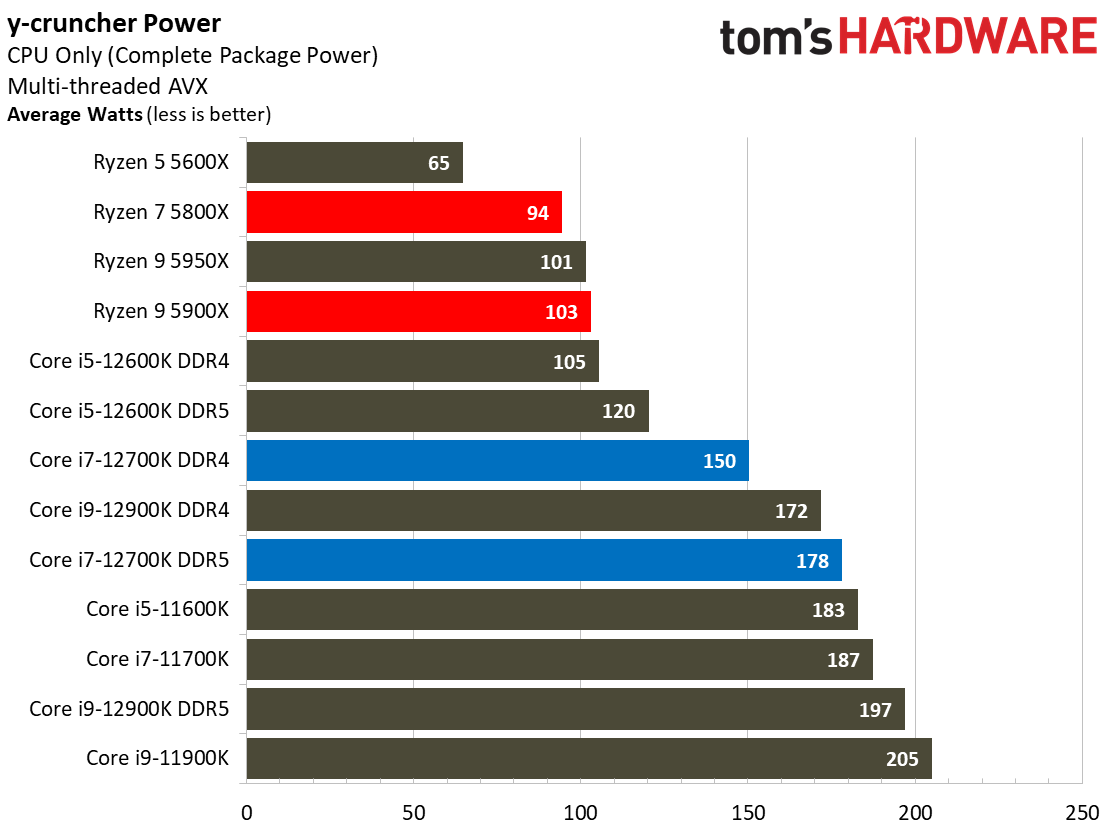
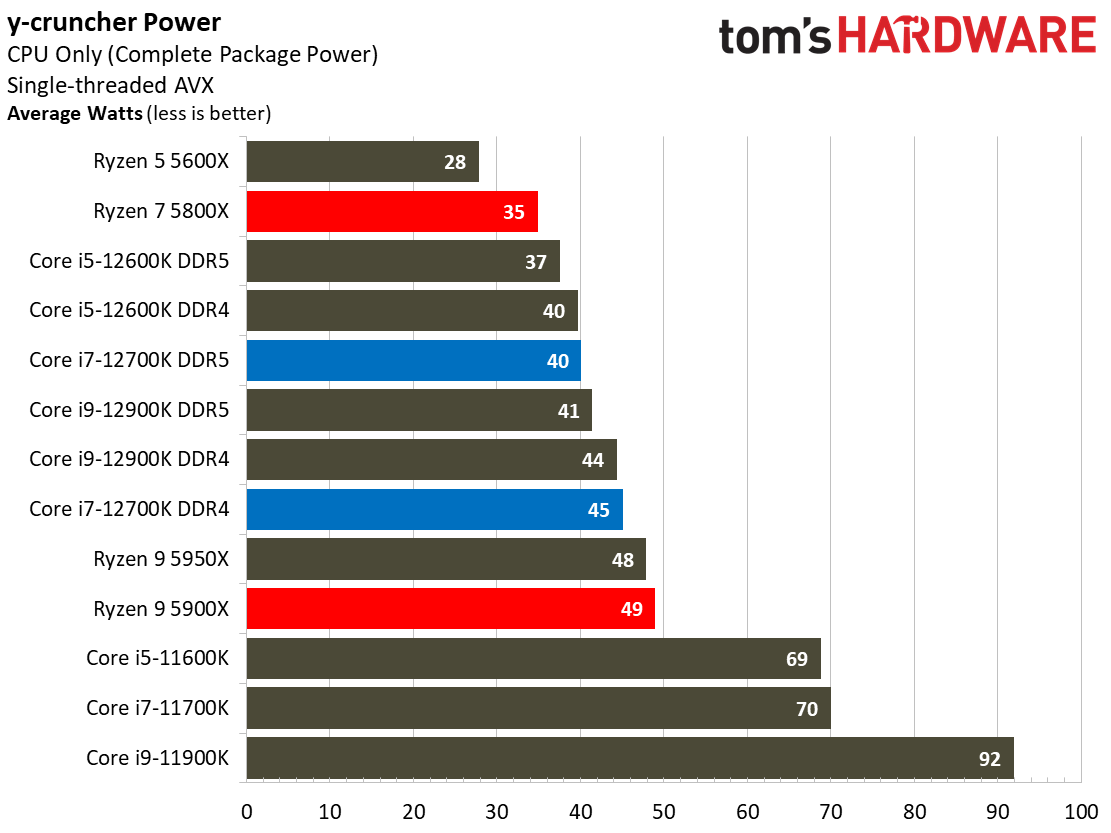


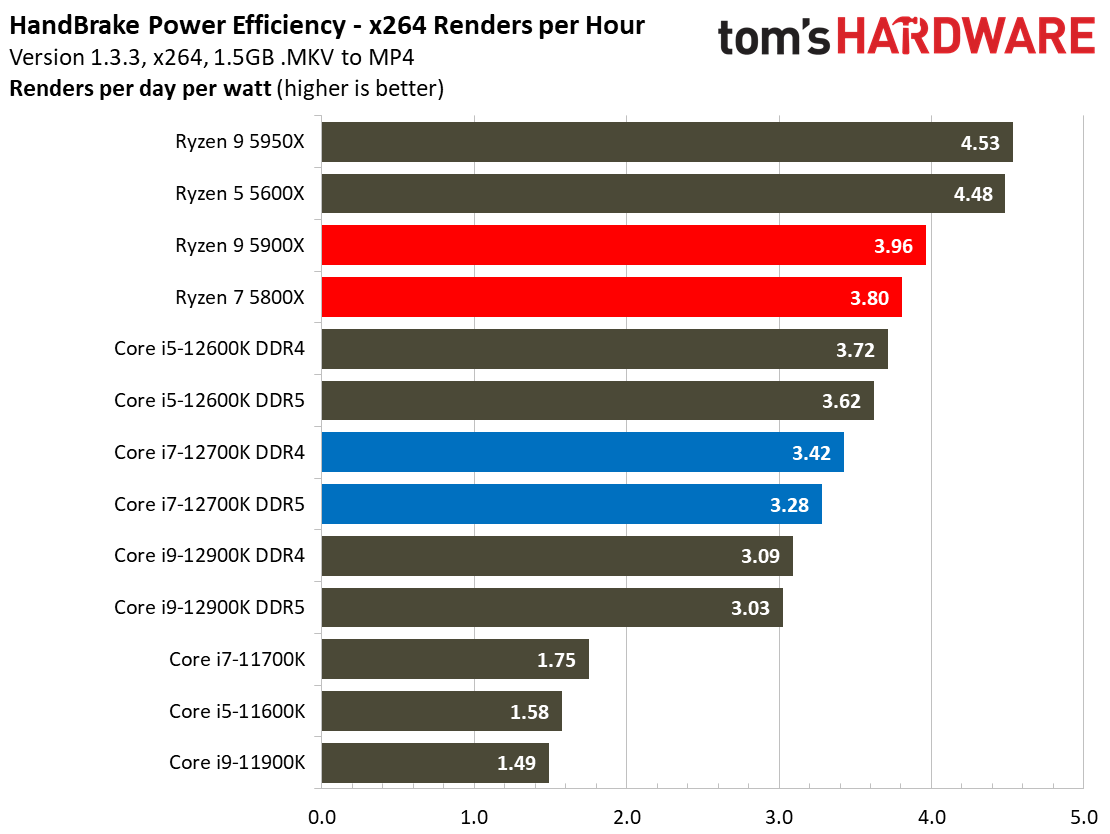


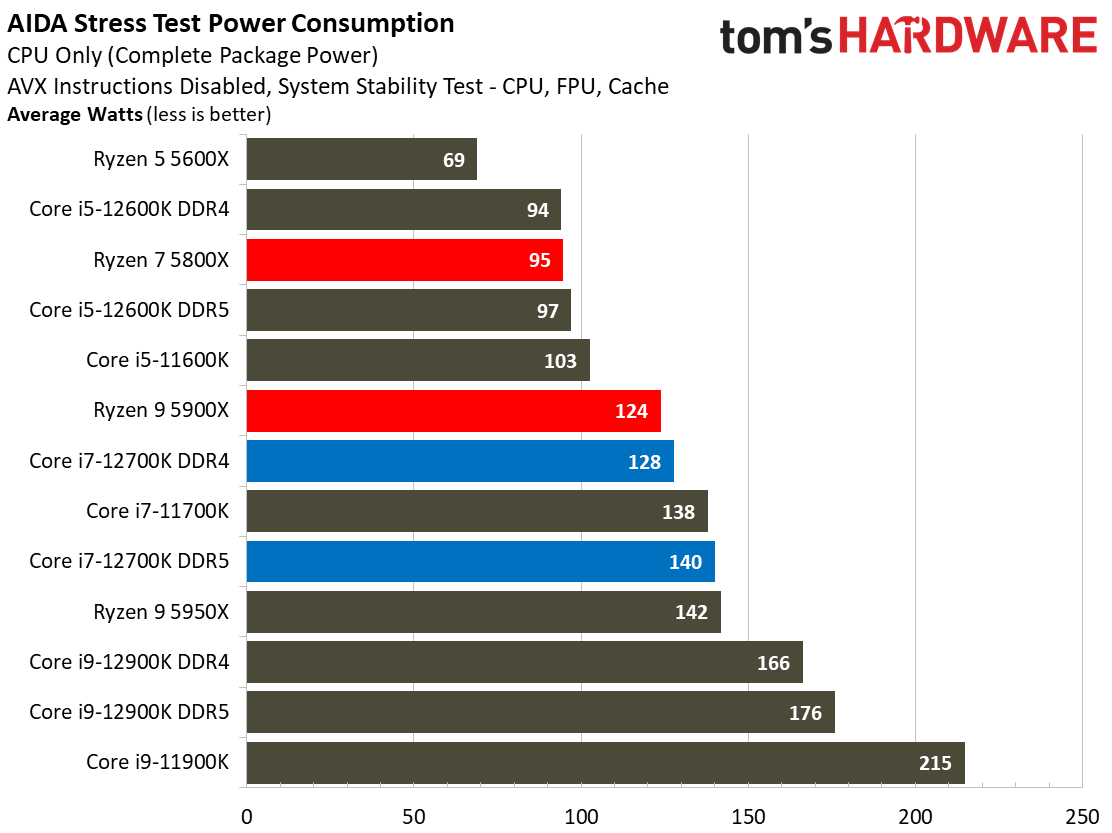
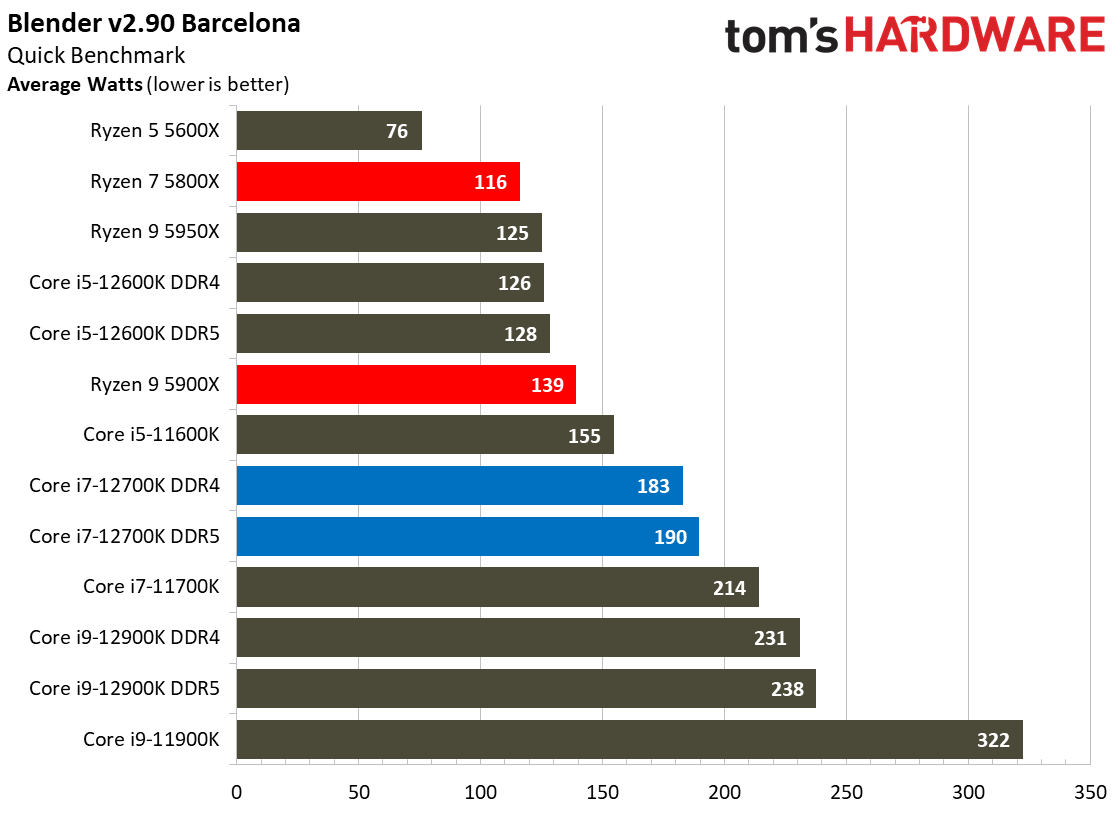



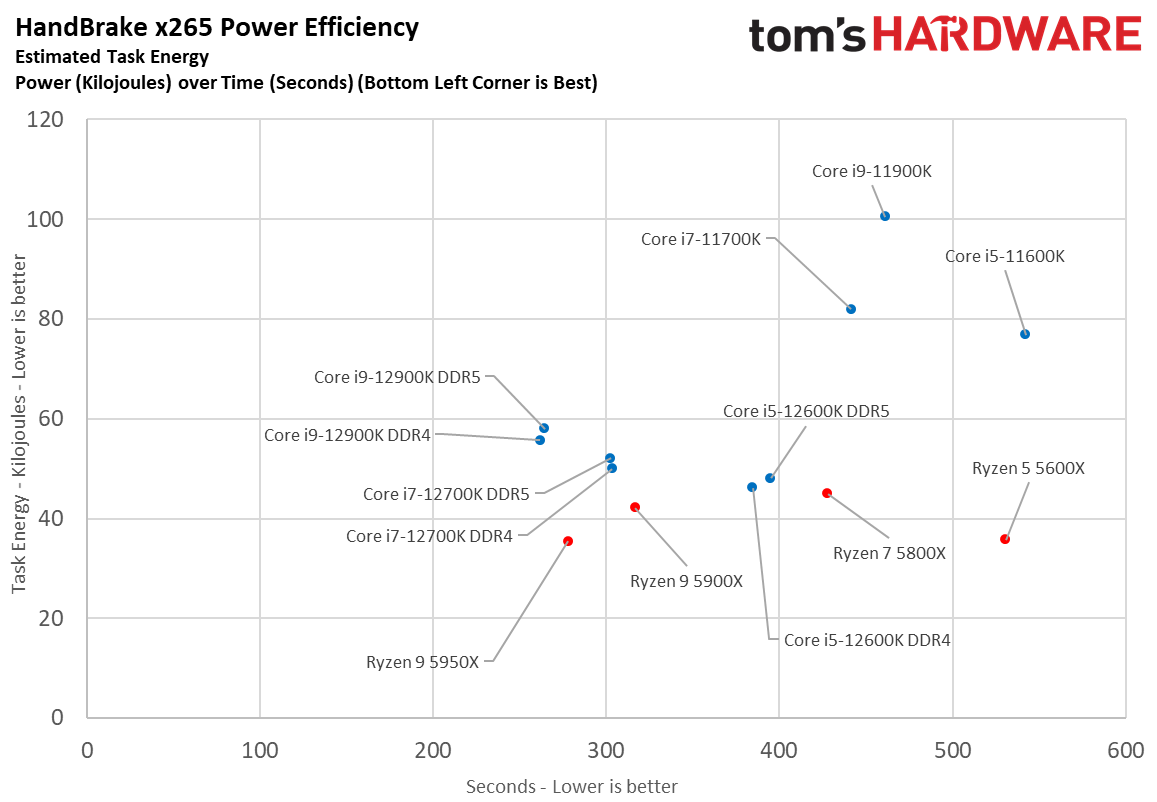

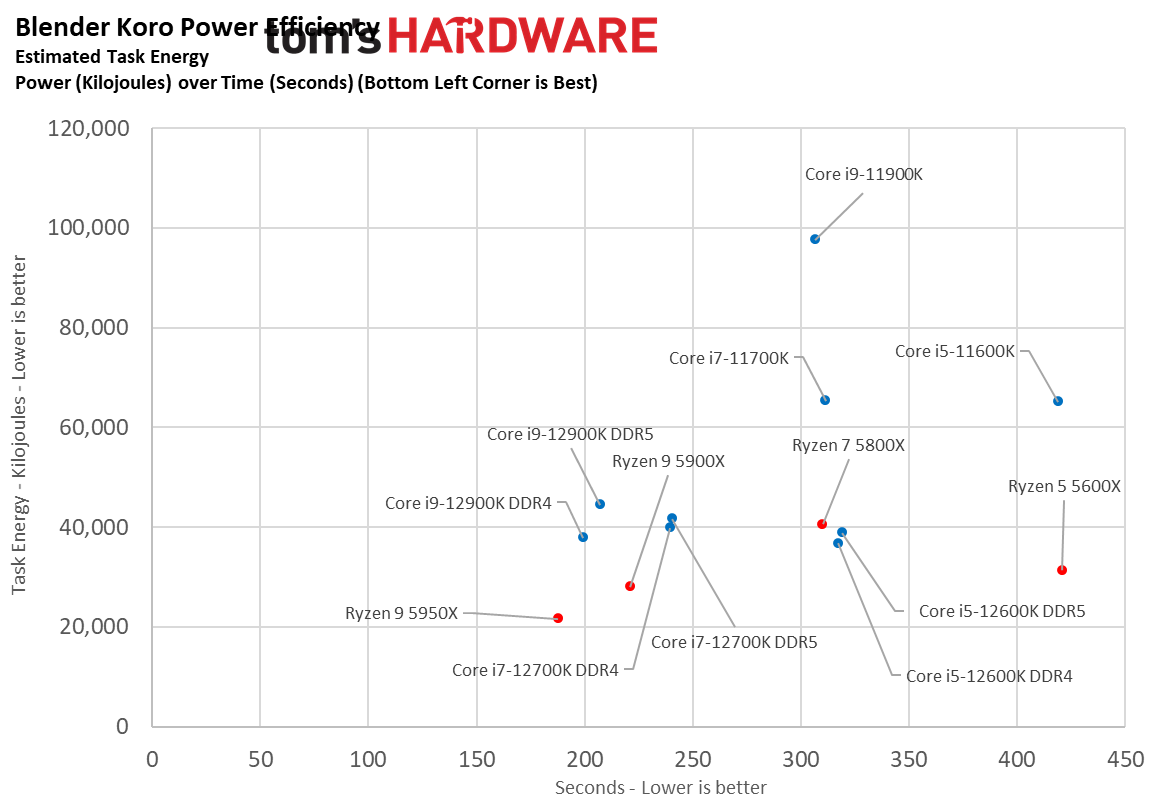
Intel's Alder Lake marks an overdue and drastic improvement to the company's power consumption and efficiency metrics. Those improvements come not only from the new architecture that shuffles heavily-threaded work to smaller, more efficient cores, but also the new Intel 7 process that reduces power consumption and improves efficiency.
The Ryzen processors are still the most power-efficient chips we've ever tested, and Alder Lake still sucks more power. However, Intel's improvement here is noteworthy: We measured a peak of 195W with the 12700K, while the previous-gen 11700K peaked at 239W.
Peak power consumption isn't the most important metric, though. The Core i7-12700K is also faster than its predecssor. As you can see in our renders-per-day measurements, the Core i7-12700K is nearly twice as efficient as the previous-gen 11700K. Overall, Intel has reduced its power consumption to an acceptable level. The Core i5-12700K ran just fine with a 280mm liquid cooler, but you could get away with a 240mm or equivalent air cooler.
The last four slides in the above album give us a different view of power efficiency. Here we calculate the cumulative amount of energy required to perform a given task. We plot this 'task energy' value in Kilojoules on the left side of the chart. These workloads are comprised of a fixed amount of work, so we can plot the task energy against the time required to finish the job (bottom axis) to give us a better look at efficiency.
Bear in mind that faster completion times and lower task energy are ideal. That means processors that are closest to the bottom left corner are best. It's easy to see that Intel has made a massive generational improvement here; the Core i7-12700K is far more efficient than the 11700K.
However, AMD still holds the advantage in all of the key power criteria, with the Ryzen 5000 models retaining the crown of the most efficient desktop CPUs that we've ever tested.
Winner: AMD
Intel has made plenty of progress, but AMD still holds the crown of the most power-efficient chips. The Ryzen 5000 chips consume less peak power and also accomplish more work per unit of power consumed. That results in a clean sweep in power consumption, efficiency, and thermal output, so you'll end up with a cooler and quieter system.
Pricing: Intel Core i7-12700K vs Ryzen 9 5900X and Ryzen 7 5800X
The Core i7-12700K has a $409 suggested price point, but you can also snag the $384 graphics-less Core i7-12700KF for $25 less. Black Friday sales aside, you'll typically find the Ryzen 7 5800X for around $390, and the 5900X for $549.
However, while the CPU is one of the most important components in the build, it is but one factor in the equation — you also need a motherboard and memory. Naturally, DDR5 memory is the elephant in the room, but that is pretty simple: You should expect to pay a massive early adopter premium for DDR5 memory, and more for the higher-end DDR5 motherboards. If you plan on going the DDR5 route, be ready to open your wallet wide — DDR5 memory is mostly out of stock or up to 50% more expensive than DDR4. If you're looking for bang-for-the-buck, DDR5 is off the table for now. Luckily, DDR4 offers nearly the same performance in most applications and faster gaming performance in Windows 10 (at least in our test environment).
For now, you have no choice but to use a Z6900 motherboard for Core i7-12700K systems, as Intel hasn't released the B- or H-series chipsets yet. In addition, all high-end Z690 motherboards support DDR5, but most (if not all) of the DDR4-compatible Z690 boards land in the lower- to mid-ranges of the Z690 stack.
In terms of pricing, building a Ryzen 7 5800X system is roughly a wash compared to a DDR4-equipped 12700K system, but you gain significantly more performance in exchange. Meanwhile, the Ryzen 9 5900X costs significantly more for the chip (at least at suggested pricing) than the Core i7-12700K, giving the Intel chip some leeway to absorb higher motherboard pricing and still maintain the performance-per-dollar edge.
We can make a few comparisons with X570 and Z690 boards, though. It's still a bit early to get the complete picture on motherboard pricing; we're seeing the normal spotty availability in the wake of a big launch. Here are a few like-for-like comparisons, but this could vary (pricing is valid only at the time of publication):
| Row 0 - Cell 0 | Price |
| MSI PRO Z690-A DDR4 | $219 |
| MSI X570-A PRO | $159 |
| ASRock Z690 Phantom Gaming 4 | $179 |
| ASRock X570 PHANTOM GAMING 4 | $154 |
| ASUS Prime Z690-P D4 | $220 |
| ASUS PRIME X570-P | $157 |
As you can see, we're looking at price deltas that range from $25 to $63 between the X570 and Z690 DDR4 motherboards, with the latter being more expensive. So, of course, you'll have to add in those costs if you plan to build an Alder Lake system.
However, there are a lot of factors involved. For instance, the Z690 platform offers more robust connectivity options, like PCIe 5.0, but you do have to pay extra for those capabilities.
Winner: Intel
Alder Lake systems equipped with DDR5 memory will carry a big premium that isn't worth the slim performance gains over DDR4 in most applications, especially with Alder Lake chips with lower core counts. Given the early state of DDR5 availability, it's hard to nail down firm estimates. However, the high pricing of DDR5 isn't worth it for most users, which removes one of the key reasons to go with an Alder Lake system.
Platform pricing for a Ryzen 7 5800X system will be close enough to a wash with the 12700K to push the focus to the 12700K's 12% faster gaming performance, 17% gain in lightly-threaded applications, and 40% advantage in threaded work. In other words, the 12700K has a clear performance-per-dollar win against the 5800X.
The Ryzen 9 5900X also carries much higher suggested chip pricing, which means the 12700K offers a lower platform cost while leading the 5900X by 7.5% in gaming, 17% in lightly-threaded work, and ~2% in threaded work, though the latter is closer to a tie when we zoom out to the overall broader picture.
Bottom Line: Intel Core i7-12700K vs Ryzen 9 5900X and Ryzen 7 5800X
| Row 0 - Cell 0 | Intel Core i7-12700K | AMD Ryzen 9 5900X and 5800X |
| Features and Specifications | X | Row 1 - Cell 2 |
| Gaming | X | Row 2 - Cell 2 |
| Application Performance | X | Row 3 - Cell 2 |
| Overclocking | X | X |
| Power Consumption, Efficiency, and Cooling | Row 5 - Cell 1 | X |
| Pricing | X | Row 6 - Cell 2 |
| Total | 5 | 2 |
The Core i7-12700K offers the lion's share of the Core i9-12900K's performance, but at a much more forgiving price point. That goes a long way to boosting the value proposition, giving the chip a five-to-two lead in this Core i7-12700K vs Ryzen 7 5800X and Ryzen 9 5900X battle.
In performance testing, the $409 Core i7-12700K beat the ~$390 Ryzen 7 5800X convincingly in just about every category, with 12% faster gaming, 17% faster performance in single-threaded work, and 40% more performance in multi-threaded applications. Given the Core i7-12700K's performance lead, it more than makes up for the roughly equivalent platform pricing with the 5800X.
Additionally, even though the ~$549 Ryzen 9 5900X costs $140 more, the 12700K was 7.5% faster in gaming, 17% faster in single-threaded work, and ~2% faster in our overall measurement of multi-threaded productivity applications. The Ryzen 9 5900X does take the lead in some heavily-threaded applications, however, so you'll have to carefully weigh your priorities and decide if the markup is worth the extra performance in some areas, or the sacrifices in others. Overall, the 12700K holds the value crown here.
The 12700K is the fastest gaming chip in its price range with both DDR4 and DDR5 memory and Windows 10 and 11. Given its aggressive pricing and 12900K-like performance, it reigns supreme as the high-end chip for gaming — the 12900K isn't worth the premium for gaming-only rigs. However, AMD will fire back with its 3D V-Cache processors that will come with up to 192MB of L3 cache per chip, which the company says infuses up to 15% more gaming performance. Those chips arrive next year, but we aren't sure if the performance gains will apply to games.
The Core i7-12700K's advantages also include platform additives, but the DDR5 and PCIe 5.0 interfaces add to platform costs. Intel's decision to hold back the B- and H-series motherboards hurts here, as pricey Z690 boards are your only option, at least for now. Support for DDR4 can help reduce the premium associated with DDR5, but that comes with a compromise: We haven't seen any flagship DDR4 motherboards yet; the highest-end models appear to be confined to DDR5. If you're going with a DDR5 build, prepare yourself for eye-watering pricing, at least until supply improves. Luckily, you won't need expensive DDR5 memory to unlock the best gaming performance — unless you have a very specific need for DDR5, it's probably best to skip it.
AMD still holds the power and efficiency crown, but the 'Intel 7' process reduces peak power consumption drastically improves power efficiency. Overall, if we take performance into account, Intel has reduced its power consumption from meme-worthy to an acceptable level.
Be aware that software updates should help resolve many of the early issues in Windows 10, but you might need to engage in some manual tweaking with some specific programs.
Despite those early challenges, Alder Lake marks a massive generational leap forward, forging a compelling blend of pricing and single- and multi-threaded performance all while delivering roughly the same gaming performance as the world's fastest gaming chip, the Core i9-12900K, but for $180 less.
Combined with leading-edge connectivity options and improved power consumption and efficiency, the Core i7-12700K wins the faceoff with the Ryzen 7 5800X and Ryzen 9 5900X in convincing fashion.
- MORE: Best CPUs for Gaming
- MORE: CPU Benchmark Hierarchy
- MORE: AMD vs Intel
- MORE: All CPUs Content
| Intel Socket 1700 DDR5 (Z690) | Core i9-12900K, Core i7-12700K, Core i5-12600K |
| Row 1 - Cell 0 | MSI Z690 Carbon WiFi |
| Row 2 - Cell 0 | 2 x16GB G.Skill Ripjaws S5, DDR5-5200 @ DDR5-4400 36-36-36-72 |
| Intel Socket 1700 DDR4 (Z690) | Core i9-12900K, Core i5-12600K |
| Row 4 - Cell 0 | MSI Z690A WiFi DDR4 |
| Row 5 - Cell 0 | 2x 8GB Trident Z Royal DDR4-3600 - Stock: DDR4-3200 14-14-14-36 |
| Intel Socket 1200 (Z590) | Core i9-11900K, Core i7-11700K, Core i5-10600K |
| Row 7 - Cell 0 | MSI Z590 Godlike |
| Row 8 - Cell 0 | 2x 8GB Trident Z Royal DDR4-3600 - Stock DDR4-3200/2933 Gear 1 |
| AMD Socket AM4 (X570) | AMD Ryzen 9 5950X, Ryzen 9 5900X, Ryzen 7 5800X, Ryzen 5 5600X |
| MSI MEG X570 Godlike | |
| Row 11 - Cell 0 | 2x 8GB Trident Z Royal DDR4-3600 - Stock: DDR4-3200 14-14-14-36 |
| All Systems | Gigabyte GeForce RTX 3090 Eagle - Gaming and ProViz applications |
| Row 13 - Cell 0 | Nvidia GeForce RTX 2080 Ti FE - Application tests |
| 2TB Intel DC4510 SSD | |
| Silverstone ST1100-TI | |
| Row 16 - Cell 0 | Open Benchtable |
| Windows 10 Pro version 2004 (build 19041.450) | |
| Row 18 - Cell 0 | Windows 11 Pro version |
| Cooling | Corsair H115i |

Paul Alcorn is the Editor-in-Chief for Tom's Hardware US. He also writes news and reviews on CPUs, storage, and enterprise hardware.
-
VforV I like how you put "aside" the latest price drops for Zen3, like they don't matter and people are idiots and don't buy at lower prices...Reply
Presumably we are all buying Zen3 at the highest prices, right, not when they are low?
12700k is one of the best from Alder Lake (actually better and makes more sense than 12900k), yeah ok, but NO, it does not win on pricing, not with these new Zen3 price drops. And there will be more, Zen3D is coming.
As for performance, sure it wins on average, but by a small margin (because there are games where Zen3 wins too), one that is not that impressive at all, unless you cherry pick specific games... but then again you can do that with Zen3 too, so that's that.
As for the gains in efficiency and power consumption with Alder Lake, I LOL-ed hard. It's pathetic vs Zen3 and if Zen3D manages +15% perf on average at the same efficiency, Alder Lake is gonna look even more pathetic. -
larkspur This is what I see on PCPartpicker right now:Reply
PCPartPicker Part List: https://pcpartpicker.com/list/Pnghgt
CPU: AMD Ryzen 9 5900X 3.7 GHz 12-Core Processor ($478.99 @ Newegg)
Motherboard: MSI B550-A PRO ATX AM4 Motherboard ($109.00 @ B&H)
Total: $587.99
Prices include shipping, taxes, and discounts when available
Generated by PCPartPicker 2021-11-27 10:17 EST-0500
PCPartPicker Part List: https://pcpartpicker.com/list/dNj8LP
CPU: Intel Core i7-12700K 3.6 GHz 12-Core Processor ($418.48 @ Newegg)
Motherboard: MSI PRO Z690-A DDR4 ATX LGA1700 Motherboard ($209.99 @ Newegg)
Total: $628.47
Prices include shipping, taxes, and discounts when available
Generated by PCPartPicker 2021-11-27 10:18 EST-0500
Not a great mobo comparison since the Z690 board has twice the m.2 slots and 2.5Gb LAN, but you get the idea. $40 more for the 12700k platform, double the m.2 slots, 2.5Gb LAN, iGPU, quicksync, PCIe 5 andleading the 5900X by 7.5% in gaming, 17% in lightly-threaded work, and ~2% in threaded work, though the latter is closer to a tie when we zoom out to the overall broader picture.
If we include platform costs and actual street prices, the 12700k vs the 5900x is a very competitive matchup. I'd have to give the edge to the 12700k though. I also think a more fair comparison might be with an x570 board that has better features (and is a better match for the 5900x). But if we do that then Ryzen loses its platform pricing advantage. -
JfromNucleon Missed oppurtutnity to title the later part of the title: Intel Ryzen (sorry, I had to)Reply -
Geezer760 Reply
Don't forget to add in the prices of the rest of the build, NVME, SSD, HD (maybe), PSU, Case, CPU cooler, and the real killer at ridiculous prices is the GPU, by that time your well on your way to a $3000+ system AMD or Intel, I personally would not pay $1000+ on any GPU that's just insane, even $700 for any GPU is pushing it, these days $500 would be the most I'd consider paying for a GPU a (3070), and less for any GPUs below that.larkspur said:This is what I see on PCPartpicker right now:
PCPartPicker Part List: https://pcpartpicker.com/list/Pnghgt
CPU: AMD Ryzen 9 5900X 3.7 GHz 12-Core Processor ($478.99 @ Newegg)
Motherboard: MSI B550-A PRO ATX AM4 Motherboard ($109.00 @ B&H)
Total: $587.99
Prices include shipping, taxes, and discounts when available
Generated by PCPartPicker 2021-11-27 10:17 EST-0500
PCPartPicker Part List: https://pcpartpicker.com/list/dNj8LP
CPU: Intel Core i7-12700K 3.6 GHz 12-Core Processor ($418.48 @ Newegg)
Motherboard: MSI PRO Z690-A DDR4 ATX LGA1700 Motherboard ($209.99 @ Newegg)
Total: $628.47
Prices include shipping, taxes, and discounts when available
Generated by PCPartPicker 2021-11-27 10:18 EST-0500
Not a great mobo comparison since the Z690 board has twice the m.2 slots and 2.5Gb LAN, but you get the idea. $40 more for the 12700k platform, double the m.2 slots, 2.5Gb LAN, iGPU, quicksync, PCIe 5 and
If we include platform costs and actual street prices, the 12700k vs the 5900x is a very competitive matchup. I'd have to give the edge to the 12700k though. I also think a more fair comparison might be with an x570 board that has better features (and is a better match for the 5900x). But if we do that then Ryzen loses its platform pricing advantage. -
Unolocogringo When Ryzen 5000 came out it was the fastest thing available.Reply
So AMD priced it accordingly.
It became the "IN" thing. Everyone had to have it for bragging rights. Which outstripped supply and prices went up.
Normal Supply/Demand economy.
Plus Ryzen5000+ is around the corner to take the gaming lead back by a small margin if all the rumors are true.
Ryzen 5000 is now "out" and Intel 12 series is the top dog for the moment.
Retailers will adjust prices accordingly.
So prices for parts change again as supply/demand determines.
Aren't we lucky that AMD's advancements have made Intel notice and try to innovate again!!!!!
This does not address the role of scalpers during the last couple years.. -
Stevemeister "which the company says infuses up to 15% more gaming performance. Those chips arrive next year, but we aren't sure if the performance gains will apply to games." . . .. .err who writes this stuff and who proof reads it. AMD state it will improve gaming performance 15% . . . .but the the comment states we aren't sure if the performance gains will apply to games !!!!Reply -
Why_Me Reply
So when is that AMD Ryzen cpu price drop going to happen?Unolocogringo said:When Ryzen 5000 came out it was the fastest thing available.
So AMD priced it accordingly.
It became the "IN" thing. Everyone had to have it for bragging rights. Which outstripped supply and prices went up.
Normal Supply/Demand economy.
Plus Ryzen5000+ is around the corner to take the gaming lead back by a small margin if all the rumors are true.
Ryzen 5000 is now "out" and Intel 12 series is the top dog for the moment.
Retailers will adjust prices accordingly.
So prices for parts change again as supply/demand determines.
Aren't we lucky that AMD's advancements have made Intel notice and try to innovate again!!!!!
This does not address the role of scalpers during the last couple years..
https://www.amazon.com/AMD-Ryzen-3600-12-Thread-Processor/dp/B07STGGQ18/AMD Ryzen 5 3600 $241.35 -
Why_Me Reply
The 12700K comes with integrated graphics something to consider when factoring in the current gpu prices. Looks like Alder Lake wins in that dept. also.Geezer760 said:Don't forget to add in the prices of the rest of the build, NVME, SSD, HD (maybe), PSU, Case, CPU cooler, and the real killer at ridiculous prices is the GPU, by that time your well on your way to a $3000+ system AMD or Intel, I personally would not pay $1000+ on any GPU that's just insane, even $700 for any GPU is pushing it, these days $500 would be the most I'd consider paying for a GPU a (3070), and less for any GPUs below that. -
TerryLaze Reply
Well AMD claimed 15% average....out of 5 games, that's the whole of the information we have about that, zero claims for productivity and only 5 games tested.Stevemeister said:"which the company says infuses up to 15% more gaming performance. Those chips arrive next year, but we aren't sure if the performance gains will apply to games." . . .. .err who writes this stuff and who proof reads it. AMD state it will improve gaming performance 15% . . . .but the the comment states we aren't sure if the performance gains will apply to games !!!!
So the article is right in doubting if it will be 15% across a wider board of games.
And yes, it's really badly worded though.
-
-Fran- As per the other comparison, you can get away with way less cooling with AMD CPUs and keep 95%+ of the performance (if not 100%). This has to be factored into the price comparison and it is not. It baffles me Tom's thinks these CPUs have the same cooling requirements, but aren't testing temperatures and power draw across the board. Why not make an article about it and see what works and how well it works for these CPUs and remove the speculation?Reply
Anyway, I don't disagree the 12700K is a nice and interesting CPU, but as per usual you're doing a disservice to people by not putting all sides on the analysis.
Also, I wouldn't say PCIe5 is an advantage for Intel just now and it's more of a whish for the future. Low end Z690 boards don't have mux'es to make the GPU lane split into the PCIe x1 or x4 slots and use DMI instead, so good luck with the NVMe's working at full speed. Also, I haven't seen any rumours (even) of GPUs moving to PCIe5, not even Intel's. Maybe that's 2 gens in the future?
Oh welp.
Regards.